Otranto, home to approximately 5000 residents, is situated along the Adriatic coast of Salento, at the easternmost edge of Italy. It’s approximately 46 km south east of Lecce (around 35 minutes by car, 1 hour by bus and 2 hours by train from the centre of Lecce). Its coast boasts a diverse landscape, featuring sandy beaches and rocky cliffs with karst caves, some of which are partially submerged.
Known as Hydruntum to the ancient Romans, Otranto takes its name from the Greek Hydrus, referring to the Idro river that ran through the adjacent valley (another version, Odruntum, is linked to the Messapian word Odra meaning “water”). The town itself is located within a picturesque inlet to the south of the river’s mouth, forming a small promontory rising 20 meters above sea level at its centre.
For many centuries Otranto represented a gateway to the east, a meeting place between two great cultures and two great seas. Nautical charts, still show the nearby lighthouse of Punta Palascia – Italy’s most easterly point – as the place of convergence of the Ionian and the Adriatic.
Here is a picturesque destination combining architectural and natural beauty, rich in history and steeped in myth and legend. From ancient relics, stunning beaches, and delicious local cuisine.
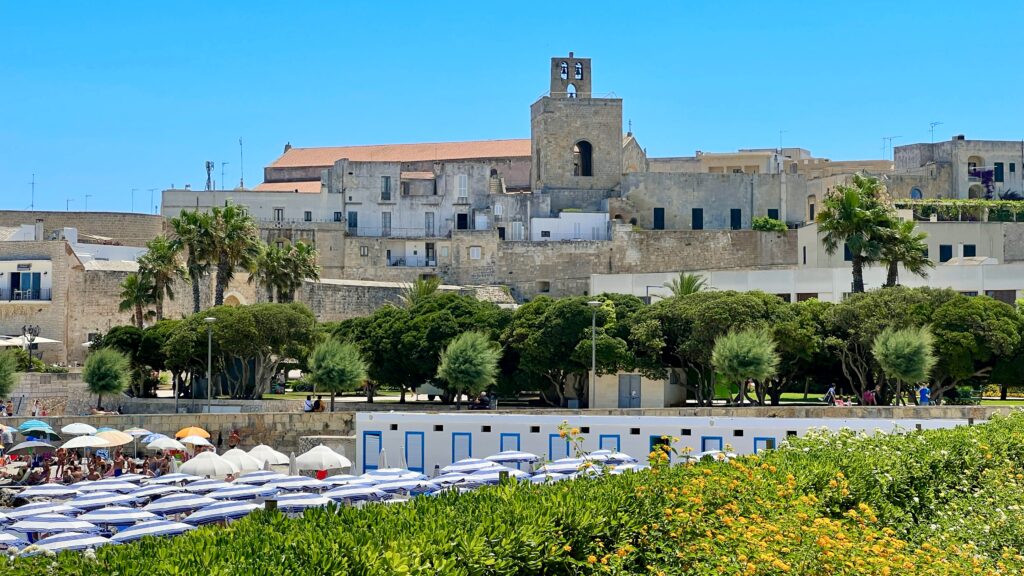
Otranto’s Ancient History
The oldest settlement in Otranto lies at the edge of the Italian peninsula, with natural harbours along the channel linking Italy to the Balkans. This route connected the Aegean Sea to northern Adriatic ports.
Evidence of Neolithic life in the Otranto area comes from an extraordinary collection of cave paintings at Grotta dei Cervi, Grotta del Mammino, Grotta Marisa, and Grotta Sacara.
In nearby Porto Badisco the Grotta dei Cervi contains hundreds of red ochre pictograms, depicting hunting scenes, social gatherings, and symbolic patterns representing collective life. The gender of figures is identifiable—women are depicted frontally, marked with a black dot, while men are shown ithyphallic and in profile. Hundreds of handprints, likely linked to initiation rituals, cover the walls.
The Grotta dei Cervi is considered a prehistoric sanctuary, a gathering place for Mediterranean communities where alliances may have been forged under the auspices of the Great Mother.
Some ritual offerings from the Neolithic period, including ceremonial vases bearing schematic depictions of the Great Mother with apotropaic significance, are preserved in an exhibition hall at Otranto Castle.
Historical sources attribute Otranto’s foundation to Cretan colonists. Recent archaeological investigations have revealed traces of an Iron Age (9th–8th century BCE) Messapian settlement atop the hill overlooking the port and concentrated around the eastern inlet. While information regarding Otranto’s history during the Magna Graecia era is scarce, there is ample evidence of consistent cultural connections between the Iapygian and Greek cultures. Moreover, Otranto’s proximity to the Adriatic, just 70 kilometres away from the other side, has historically made it a vital hub for trade.
Following the Tarentine War, the Messapians allied with Taranto (a Spartan-founded city) but ultimately fell to Rome.
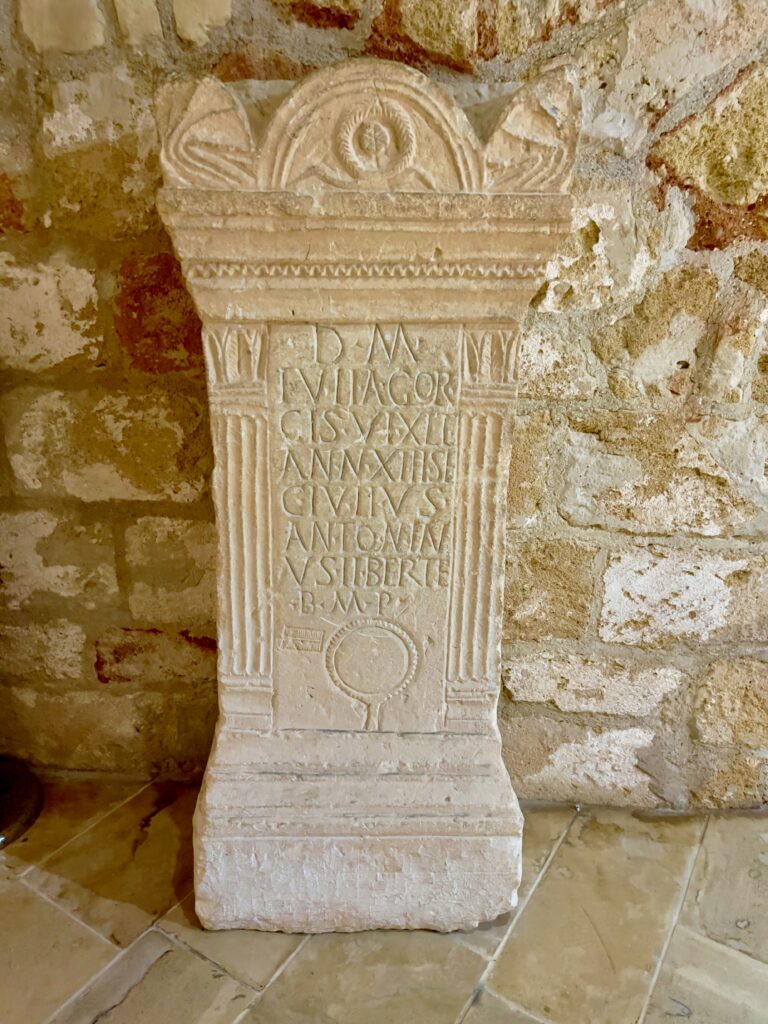
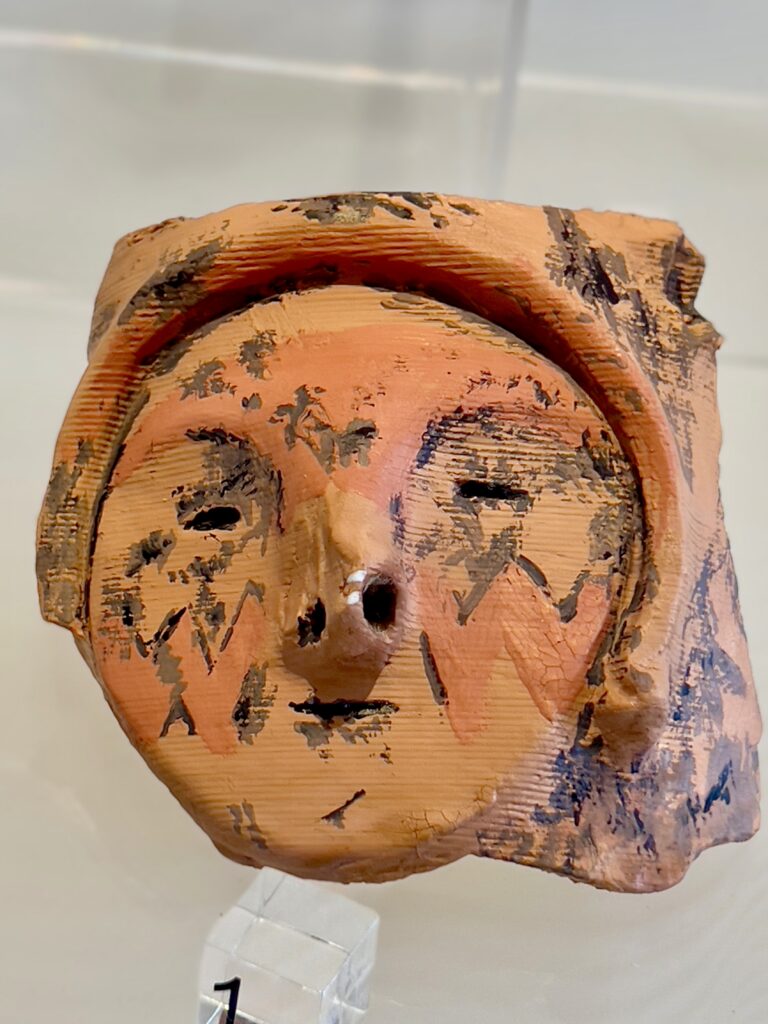
Roman Otranto
The Roman conquest of Salento in 261 BC, amidst the Samnite and Tarentine wars, led to a general decline in the region’s cities. Otranto managed to thrive as a significant crossroads linking Brindisi and Taranto, both of which were connected to the Appian consular road. It also served as a base for maritime journeys to the Epirote and Peloponnesian coasts.
Recent excavations between the historic centre and the sea reveal Otranto’s expansion during Roman times. Roman remains in Otranto are sparse, but notable examples include two slabs with Latin inscriptions honouring emperors Marcus Aurelius and Lucius Verus. These inscriptions, now part of an 18th-century doorway, suggest that Lucius Verus may have departed from the Roman port of Hydruntum for the Parthian Wars (161–166 CE).
While Otranto played a secondary role in Roman trade compared to Brindisi, its importance surged during the Byzantine era following the fall of the Roman Empire.
Byzantine Prosperity
After the decline of Roman power, Otranto came under Byzantine rule.
By the late 6th century, a wave of Greek-Byzantine settlers significantly influenced Otranto, transforming it into a cultural and political epicentre. The city, now fortified against barbarian attacks, embraced Greek culture with the settlement of public officials, notaries, ecclesiastics, and traders. Nearby, the Basilian monastery of San Nicola di Cásole became a pivotal center for spreading Byzantine culture throughout southern Italy. Although only a few ruins remain today, this monastery played a vital role, particularly through the Basilian monks who settled in Calabria, Basilicata, and Puglia.
Under the second Byzantine rule, following the reconquest of the region during the 9th century, Otranto flourished, adopting the Greek rite, as evidenced by the 10th-century Church of San Pietro in the historic centre. A significant Byzantine relic, it likely served as a focal point for religious life in Otranto until the construction of the cathedral in the 11th century.
During this period of prosperity the city became a vital base for imperial troops’ landings. Even after the Norman conquest in 1068, which faced fierce resistance from the Byzantines, Otranto continued to attract Venetian, Greek, Armenian, Jewish, and Slavic merchants. The thriving community is evident from the grand cathedral, consecrated by archbishops from Benevento, Bari, Taranto, and Brindisi, with its famous mosaic floor, completed under Archbishop Jonathan in 1166.
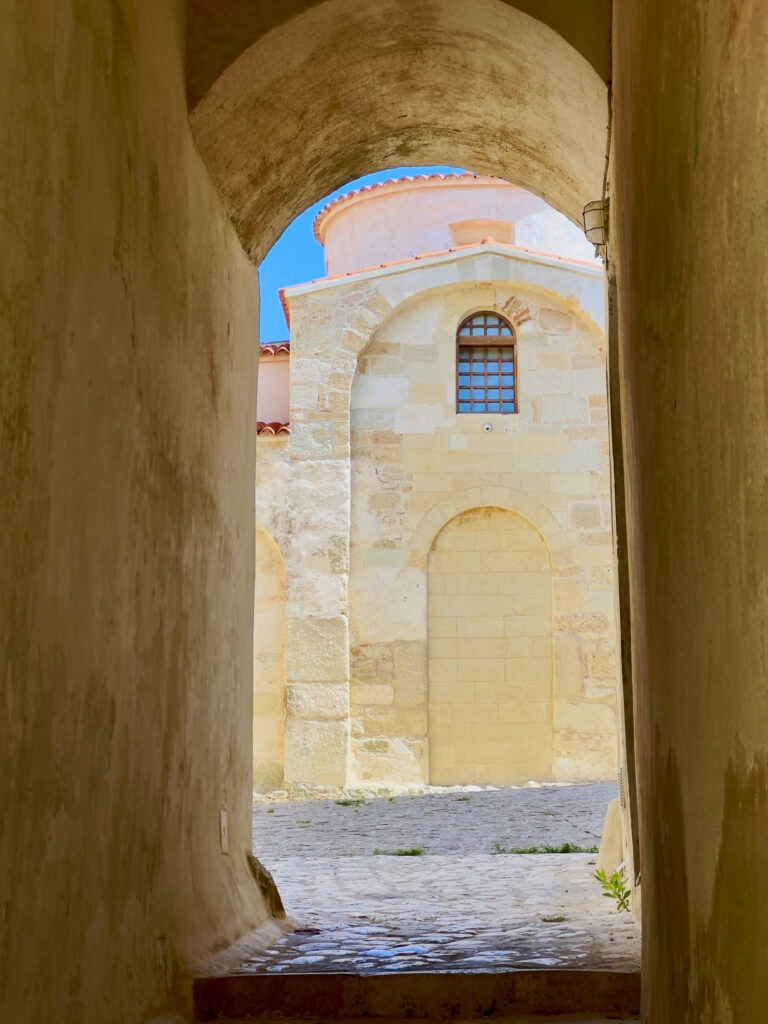
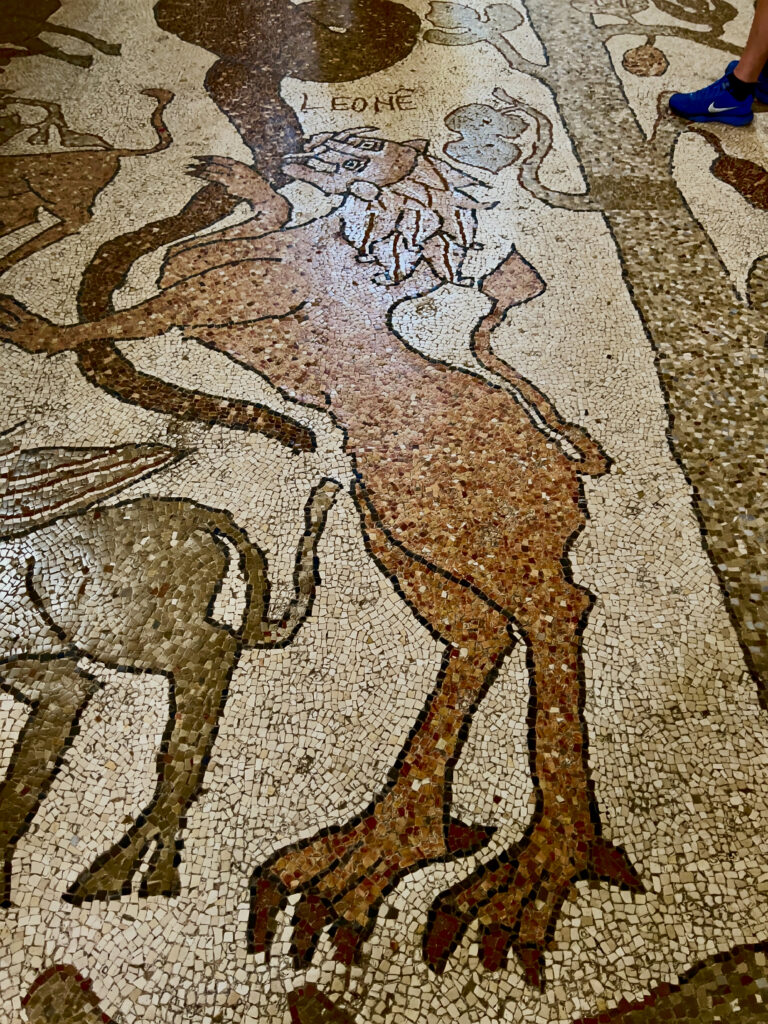
Otranto Cathedral
The city’s crowning glory is the Cathedral of Santa Maria Annunziata, built in the 12th century on the site of earlier Messapian, Roman, and early Christian structures. Consecrated in 1088, it showcases centuries of history, particularly through its mosaic floor, created between 1163 and 1165 during the Norman reign of William the Bad. The mosaic, signed by the presbyter Pantaleone, depicts a Tree of Life, an intricate medieval visual summary blending allegories, biblical themes, and folklore.
The artwork includes representations of Alexander the Great’s ascent to the heavens, King Arthur, the Tower of Babel, the Flood, Solomon and the Queen of Sheba, and scenes of Heaven and Hell. Pantaleone’s mosaic reflects Otranto’s cultural diversity, where Christianity and Judaism coexisted, with a vibrant Jewish community of 500 families in the 12th century.
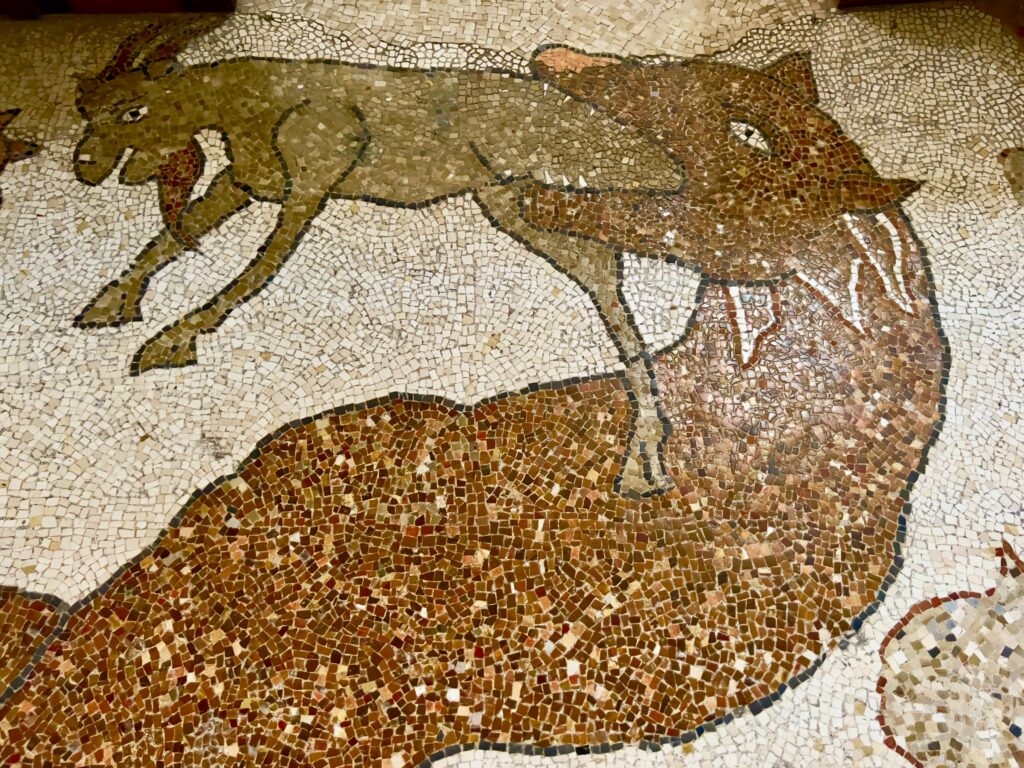
The 1480 Massacre
Otranto’s fortunes took a downturn as the Norman monarchy shifted its focus towards the Tyrrhenian side of the peninsula. Within Salento, Otranto had previously served as the capital during the Byzantine era, but it lost its prominence.
The Ottoman siege of 1480 was a dark chapter in Otranto’s history, pitting the Christian West against the Muslim East. On July 28th of that year, a Turkish fleet led by Acmet Pasha appeared on the northern horizon of the city, initially headed for Brindisi but diverted to Otranto by a storm. This expedition was part of Muhammad II‘s plan to subjugate southern Italy and reconnect with the Muslims of Spain. Otranto endured a brutal siege, After fierce resistance, resulting in the destruction of its fortifications, 18,000 Turks captured the city on August 12th.
Following the conquest, Acmet Pasha gave the city’s able-bodied men a grim ultimatum: convert to Islam or face death. Eight hundred Martyrs who refused to renounce their faith were executed on the Colle della Minerva, located “three hundred steps” from the city, on August 14th.
Otranto was reclaimed by Christians the year after, with Alfonso, Duke of Calabria, receiving the city’s keys from the defeated Turks on September 8th. On October 13th, the remains of the Martyrs were interred in the cathedral’s crypt by order of Pope Sixtus V. Still displayed in glass cases in the cathedral, they serve as a sombre reminder of human mortality and resilience.
Every year, on August 14th, a solemn procession and religious ceremonies are held to honour their memory.
The city never fully recovered from the events of 1480. The destruction, along with the decimation of the population, dealt a severe blow to the Otranto’s civil and commercial life. Subsequently, piracy plagued the coastal regions of southern Italy, contributing to a pervasive sense of insecurity.
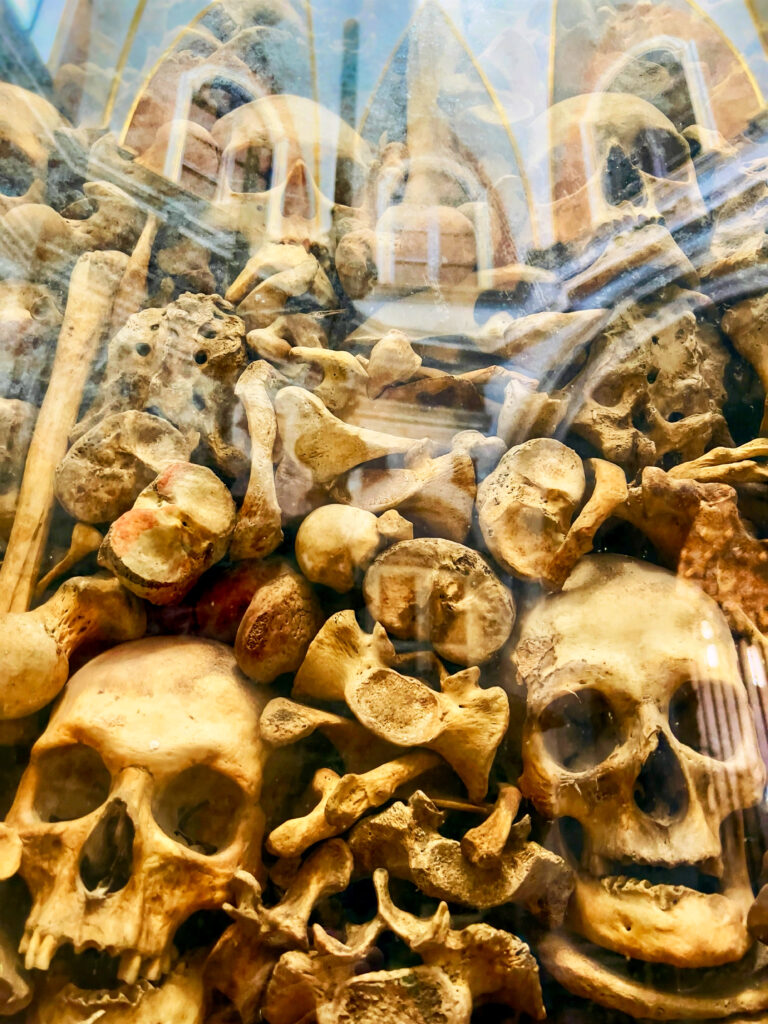
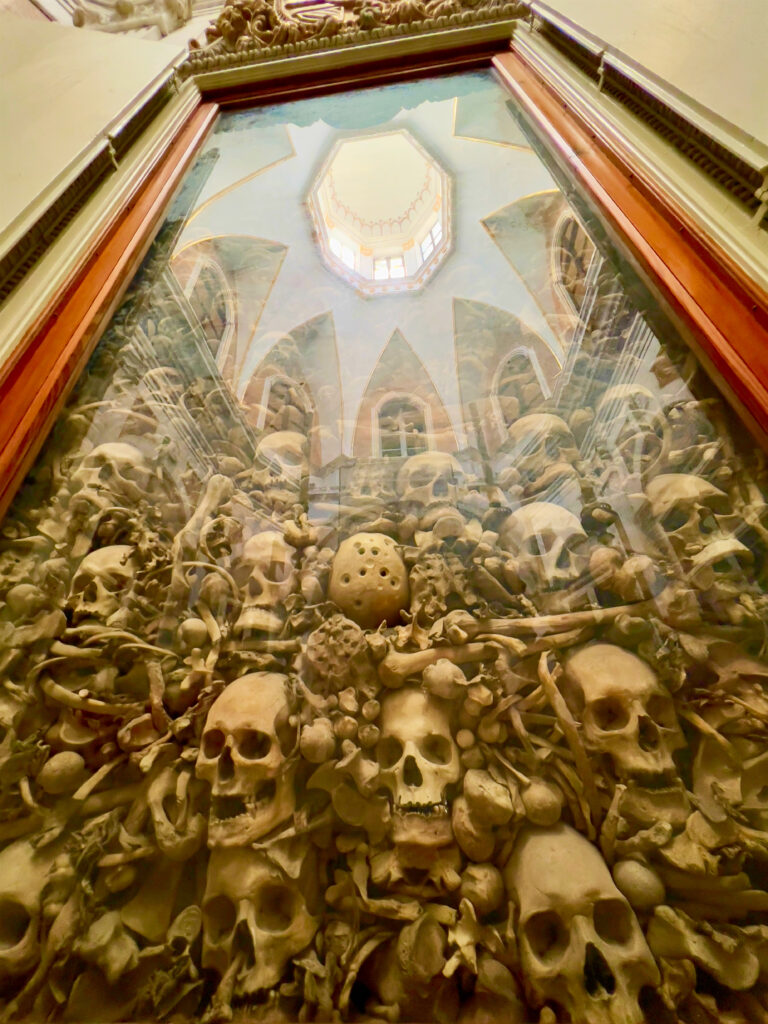
Exploring the Old Town | Must-See Sites and Walking Tour
1. Otranto Cathedral (Basilica di Santa Maria Annunziata)
The cathedral is built on the site of earlier Messapian, Roman, and early Christian structures. Its façade, dating back to 1088, rises prominently on Piazza Basilica and stands as one of the most significant examples of Apulian Romanesque architecture. A 15th-century rose window, displaying Gothic-Arabic design, adorns the center of the façade, overlooking a 17th-century portal. The bell tower, coeval with the Cathedral, stands in the northeastern corner of Piazza Basilica and takes on a square plan spanning two stories.
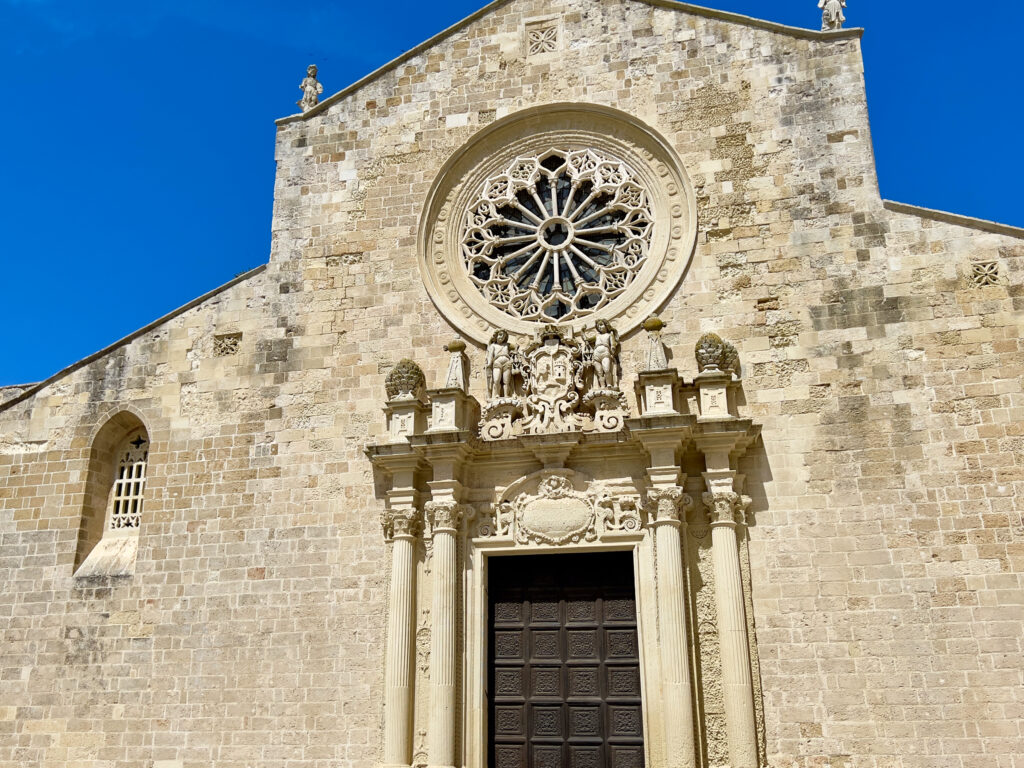
Inside, is one of the largest and best preserved medieval floor mosaics in Europe. The mosaic, which spans the length of the central nave and parts of the side naves, consists of around 10 million individual tiles. Created between 1163 and 1165 by the monk Pantaleone of San Nicola di Casole monastery, the mosaic stretches over 52 metres in length and 16 metres in width, crafted from glass paste and terracotta. This synthesis of Greek, Byzantine, and Norman cultural themes reflects Otranto’s cultural diversity. The grand Tree of Life rises at the centre, its roots near the cathedral entrance and its branches extending towards the apse.
The Tree of Life is a motif woven into the cultural fabric of civilisations across the world. It symbolises humanity’s shared quest for knowledge, spiritual enlightenment, and continuity. This is vividly displayed in the cathedral’s enigmatic mosaic floor, a monumental narrative of history, spirituality, and art.
At the heart of the mosaic, the Tree of Life is supported by two elephants—symbols of strength and endurance. Scenes from the Old and New Testaments intertwine with mythological and historical figures, creating an allegorical representation of humanity’s moral and spiritual journey.
Encompassing themes from the Holy Scriptures such as genesis, the flood, Solomon and the Queen of Sheba, with scenes of heaven and hell. The mosaic includes representations of Ancient Roman bestiarii, months of the year, and Atlas with the globe on his shoulders. There are depictions from classical and Breton legends: Alexander the Great’s ascent to the heavens and King Arthur. The placement of each element follows a deliberate order, guiding the observer along a path of reflection and enlightenment.
A Masterpiece of Cultural Synthesis
The mosaic embodies the artistic and philosophical spirit of the 12th century, a time when Southern Italy flourished under Norman rule. The Normans, having established control over the region, fostered an environment of intellectual exchange. Scholars translated works from Greek, Arabic, and Latin, while the rulers promoted religious tolerance, allowing diverse communities to coexist. This is mirrored in the cathedral’s architecture, where Doric, Romanesque, Corinthian, and Ionic influences blend harmoniously.
The fall of Otranto to the Ottoman forces of Mehmed II, lead to the massacre of its inhabitants and the desecration of the cathedral. The mosaic suffered significant damage, yet it endured, much like the spirit of the city itself. Careful restorations in the 20th century revived its splendour, and in 2010, Otranto was recognised as a UNESCO World Cultural Heritage Site.
The ceiling is built in Moorish style.
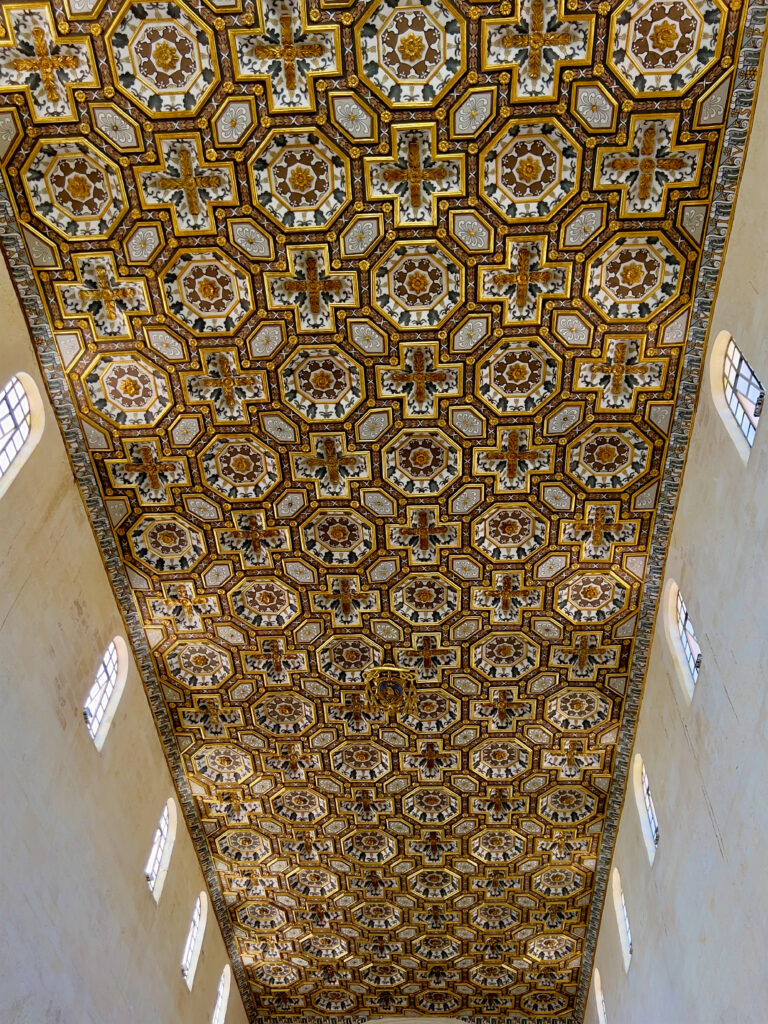
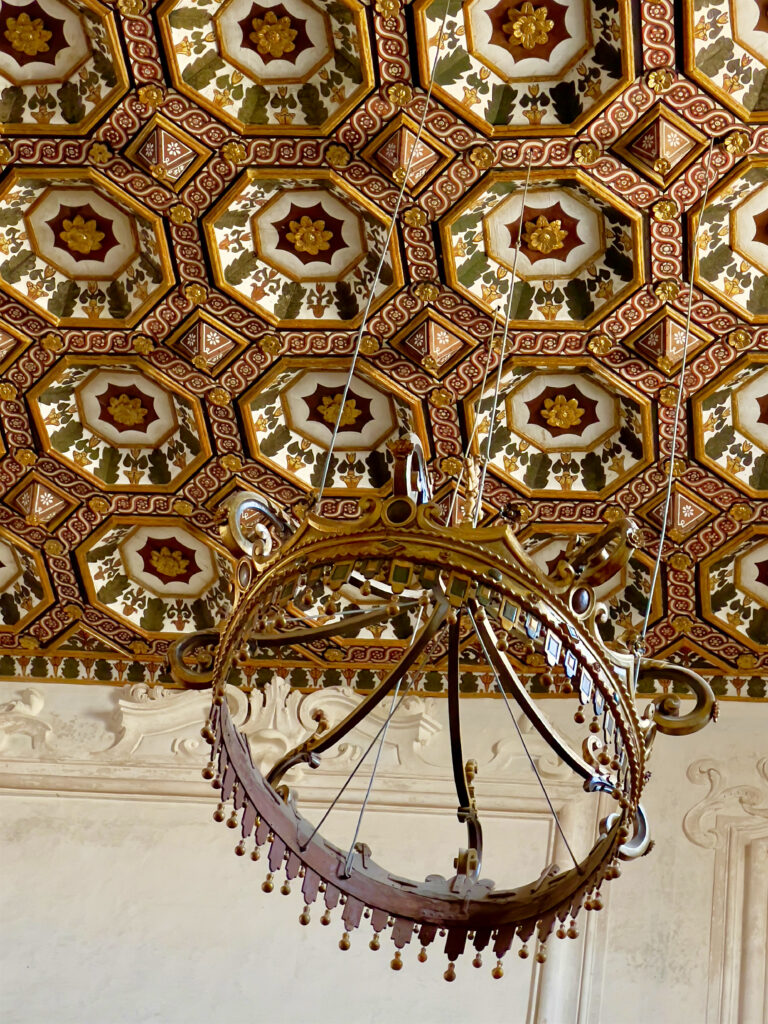
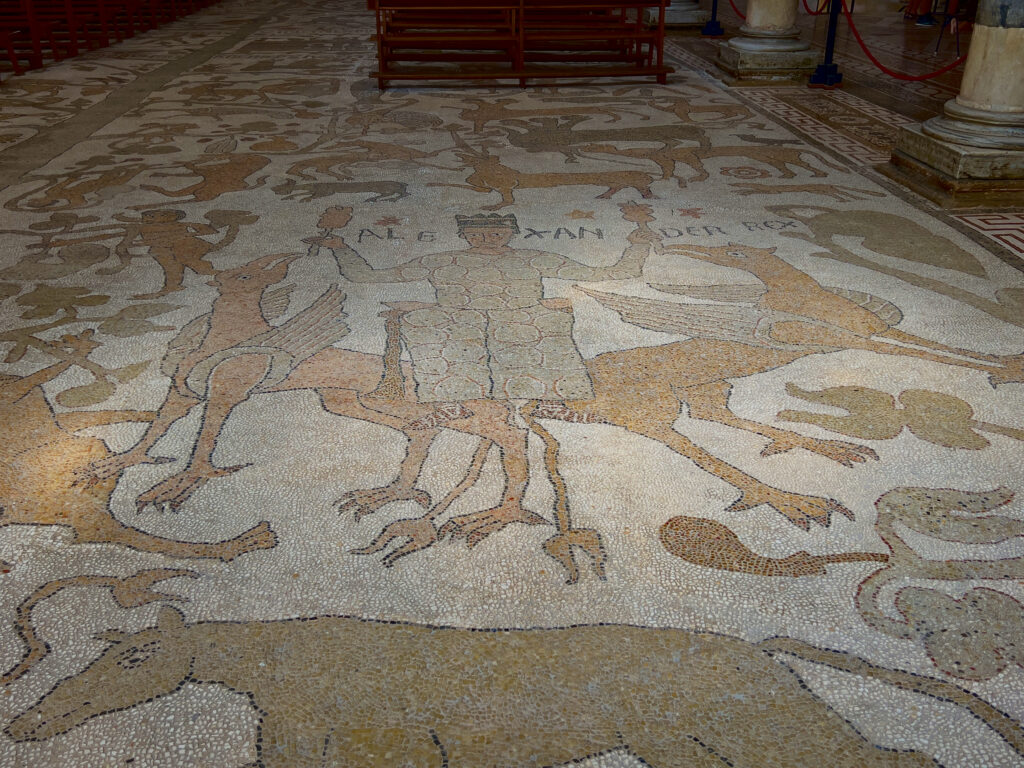
The cathedral has three naves, each marked by fourteen granite columns crowned with Romanesque capitals. Byzantine influences are evident in some wall paintings, underscoring their importance during the cathedral’s construction. Wooden cases in the right apse chapel house the relics of the eight hundred Martyrs. Beneath the apse, you’ll find the expansive crypt, featuring a ceiling supported by 68 columns, showcasing a variety of sculpted capitals—ranging from classical to Byzantine. These columns are interconnected by cross vaults.
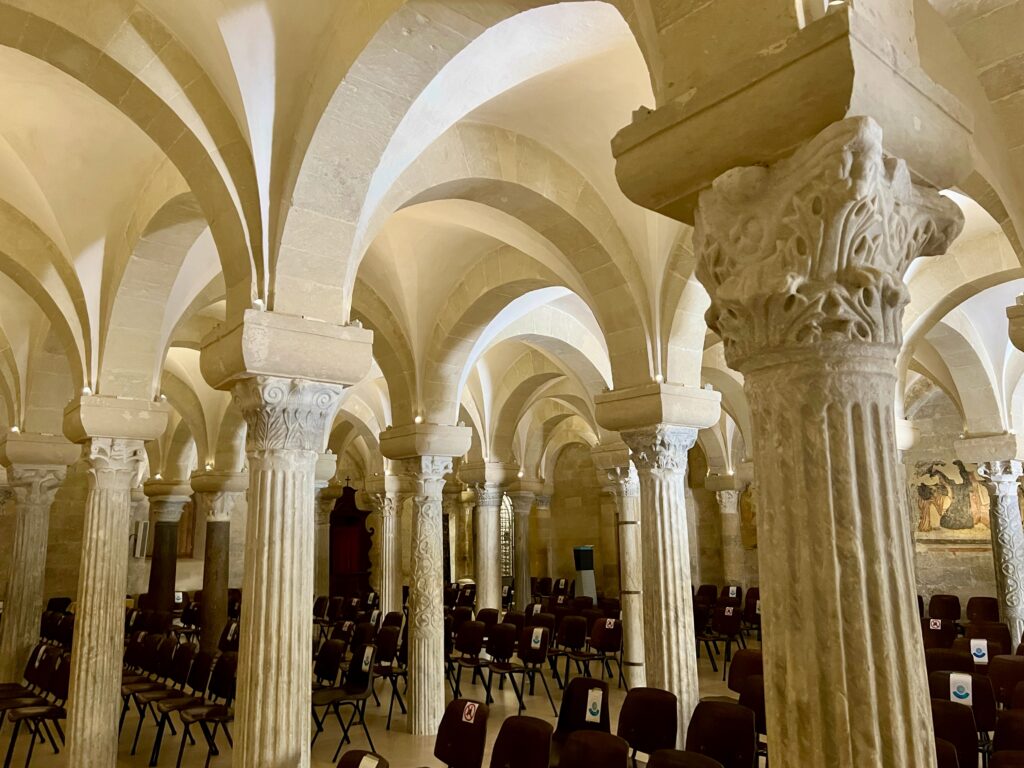
Admission to the cathedral is free of charge.
2. Castle of Otranto (Castello Aragonese)
This formidable structure was initiated after the 1481 reconquest of Otranto by the Aragonese. Spanish viceroys, particularly Toledo, fortified it further by adding external bastions to enhance the city’s defenses and adapt to evolving offensive techniques. The castle boasts a pentagonal design, featuring three circular towers at three of its corners, while the northeastern corner is reinforced with a sharp spur extending toward the port. The entrance is surmounted by Charles V’s imperial coat of arms, and within, a courtyard leads to a gallery on the upper floor, offering access to various rooms.
Originally a Swabian fortification, one of the towers within the structure of the Castello Aragonese was built under the supervision of Duke Alfonso of Aragon, following the city’s reconquest following Turkish occupation. Later, in the 16th century, Spanish viceroys further fortified Salento’s centres due to ongoing pirate incursions (a new Turkish landing near Otranto occurred in 1537). Enhancements by the Venetians added artillery and bombards.
The castle inspired Horace Walpole’s 1764 gothic novel The Castle of Otranto and Voltaire’s 1769 comic opera Le Baron d’Otrante.
Today, the fortress serves as a cultural center hosting art exhibitions and events. Entrance fee €12 (check website for current pricing).
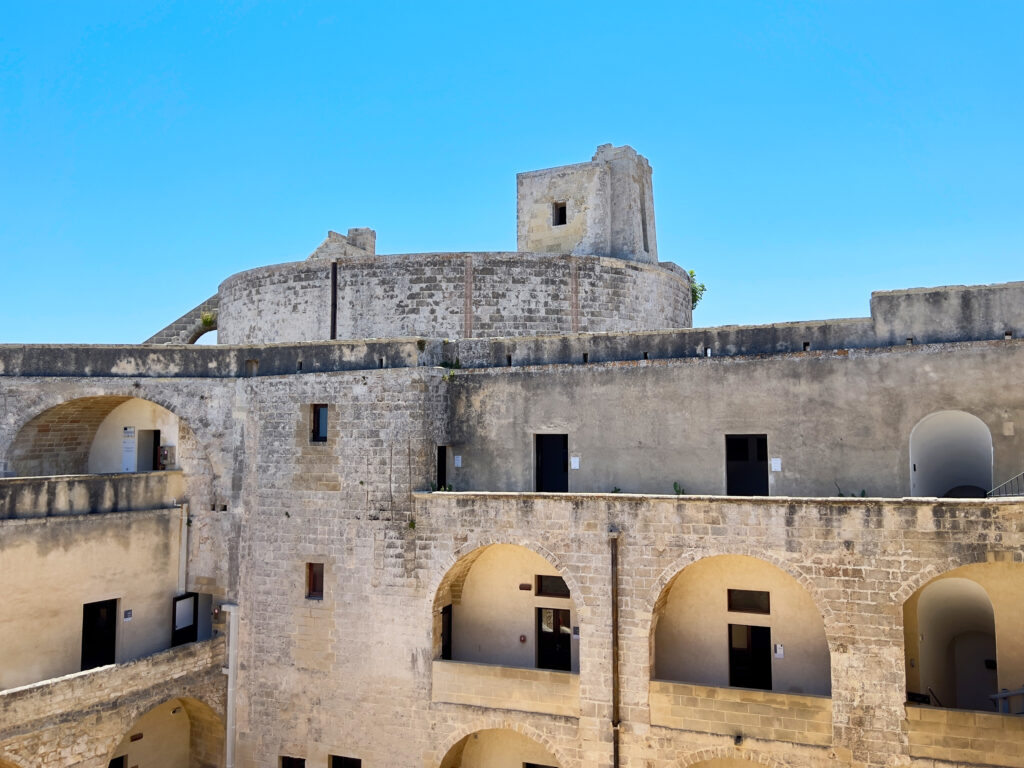
3. Land Gate (Porta Alfonsina) and Old Town
The present-day fortifications of Otranto can be attributed to two phases. The Land Gate and the Aragonese Castle.
Following the reconquest of Otranto ending Turk occupation, the Aragonese constructed new defences including the Porta Alfonsina outer gate to the old town with its two side towers. From here wander through into the historic center of Otranto. Stroll along the narrow streets, lined with white-washed buildings and local shops, and immerse yourself in Otranto’s history.
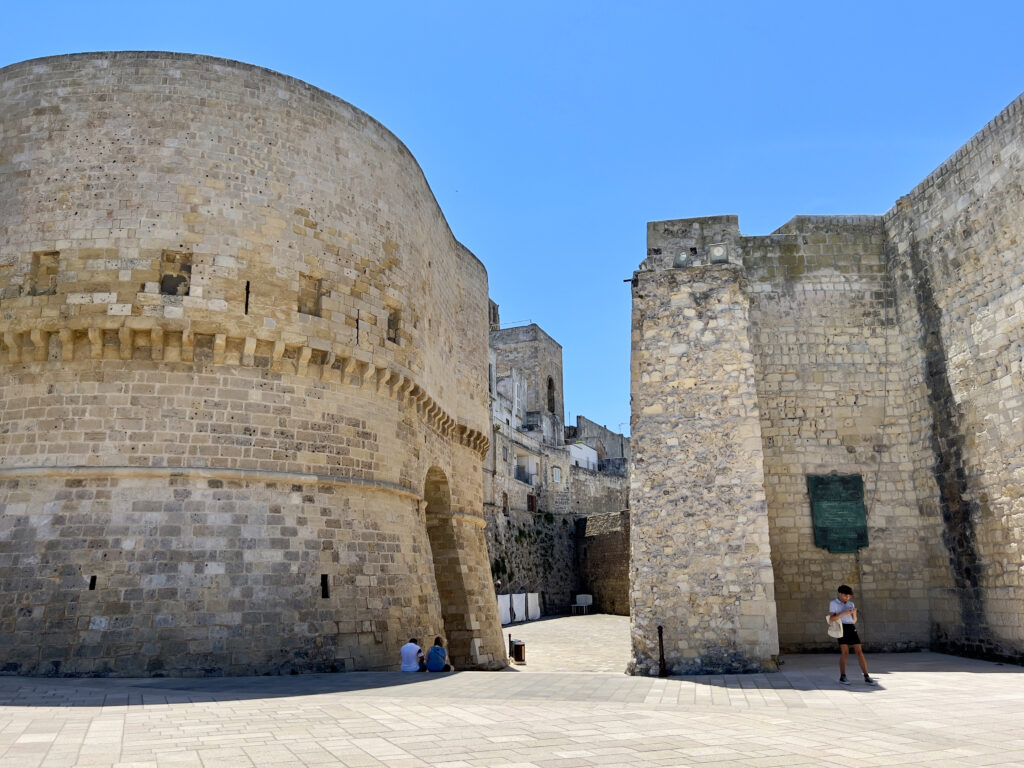
4. Otranto Martyrs’ Monument
A somber reminder of the town’s tragic past. A bronze female figure holds up the cross and the flag and is placed on a stand about 3m high, while on its head lies the crest of Otranto, tower and snake; below the Dolphin with the crescent moon, symbol of the province of Salento. The monument, created by sculptor Bortone, was inaugurated on December 3, 1924 by Crown Prince Umberto di Savoia.
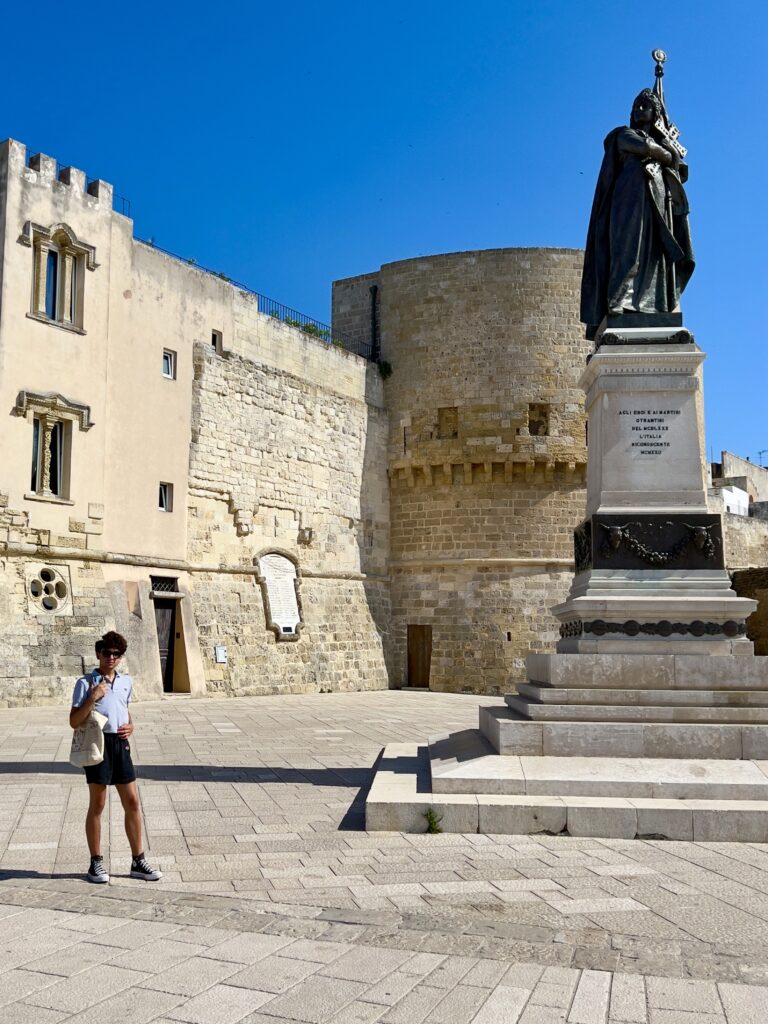
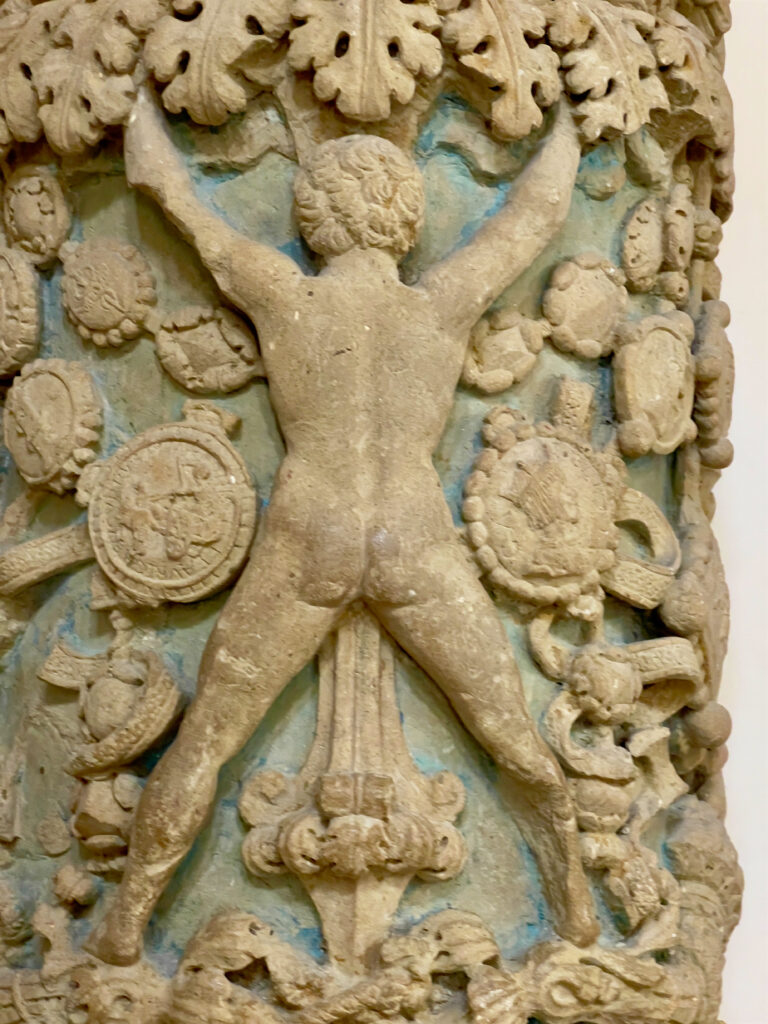
5. St. Peter’s Basilica (Basilica di San Pietro)
Discover the ancient St. Peter’s Basilica, a Greek cross-shaped church with remarkable Byzantine frescoes and a unique Arabic-style invocation to Allah. [Currently closed, but hopefully open in time for summer 2025].
Walking Tour of the Old Town | What To Look Out For
Enter the city walls through the Porta Alfonsina, with its interlocking system of two circular towers, dedicated to Alfonso of Aragon. Several other towers within the city walls are attributed to Alfonso’s vision, including the Duchesca, the Ippolita and the southwestern tower of the castle.
Wandering through Via Alfonso d’Aragona, you’ll traverse Largo Cavour. The chianche-paved streets (large limestone slabs), two-story buildings—some with internal courtyards—and Turkish cannonballs displayed at street corners betray the city’s history.
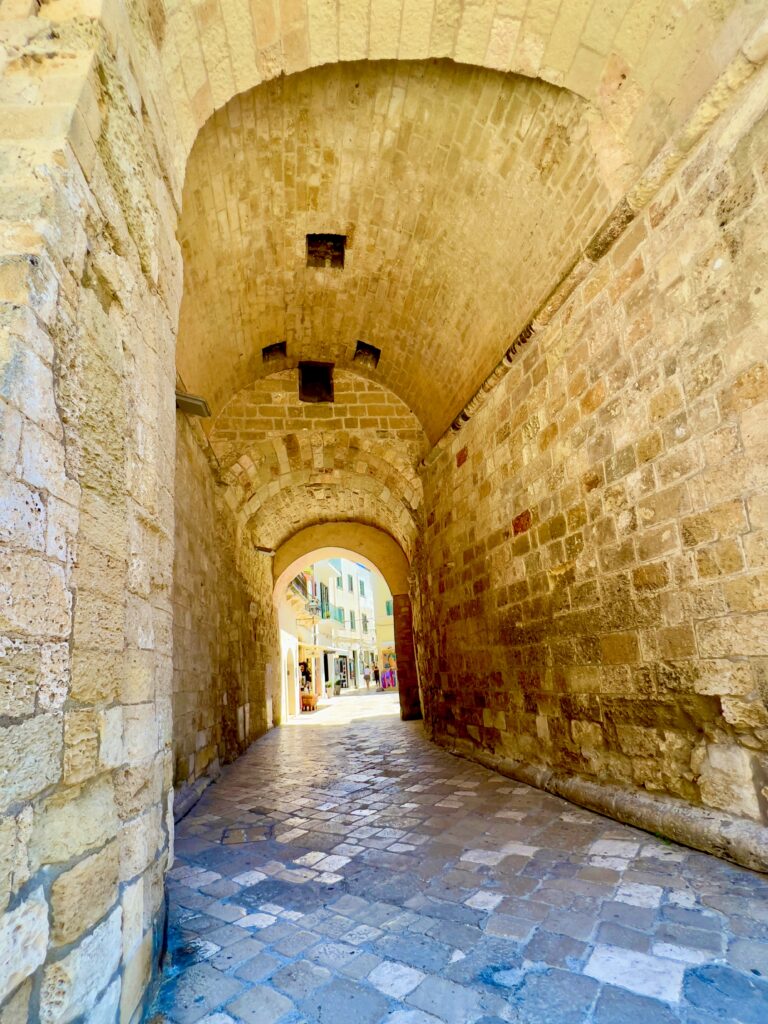
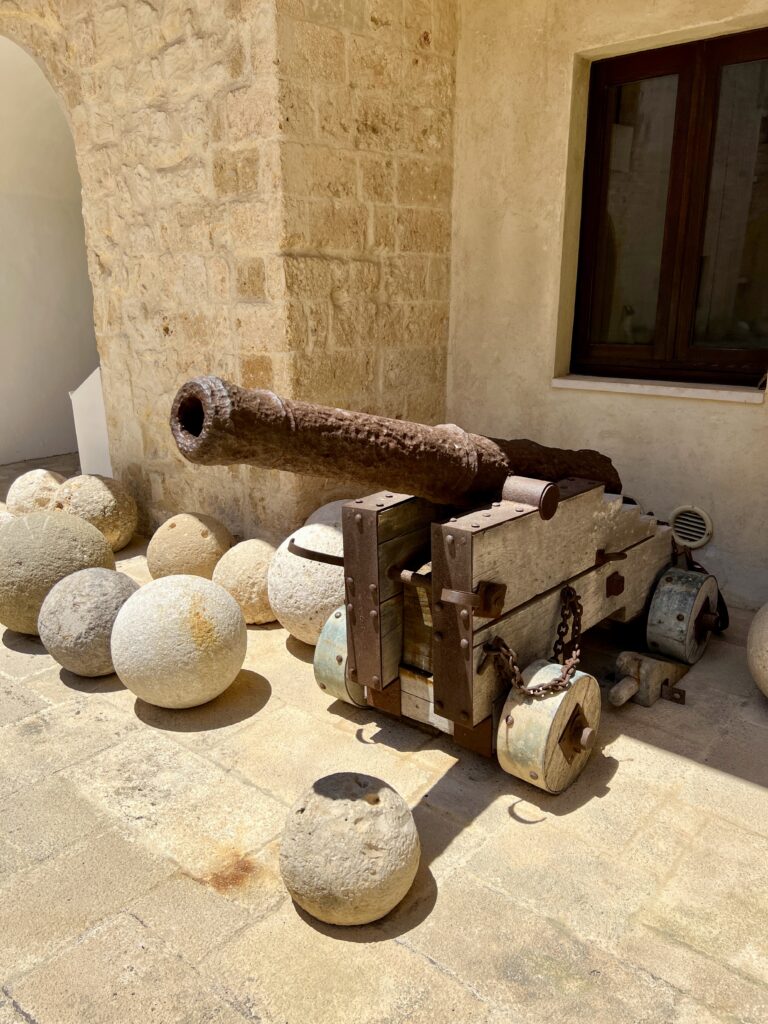
Following Corso Garibaldi, a lively thoroughfare lined with shops and cafes, you’ll arrive at Piazza del Popolo, the heart of the old town.
A short detour up Via Scupoli on your left takes you to a hidden treasure—Basilica di San Pietro. This small yet historically rich Greek church has a cross-shaped layout supported by eight columns with unique prismatic capitals. The central columns support a modest dome, while the lateral ones blend into the walls. Latin and Greek inscriptions near the entrance, hint at the Puglia’s layered history. Outside, three semicircular apses protrude with cylindrical elegance.
Continuing along Via Leondari on the right and passing under an arch, emerge onto the Via dei Bastione, take a left turn towards Bastione dei Pelasgi. The walk along the bastion offers a vantage point for observing the configuration of the port, nestled in a natural inlet, flanked by the pier on the right and the ramparts on the left.
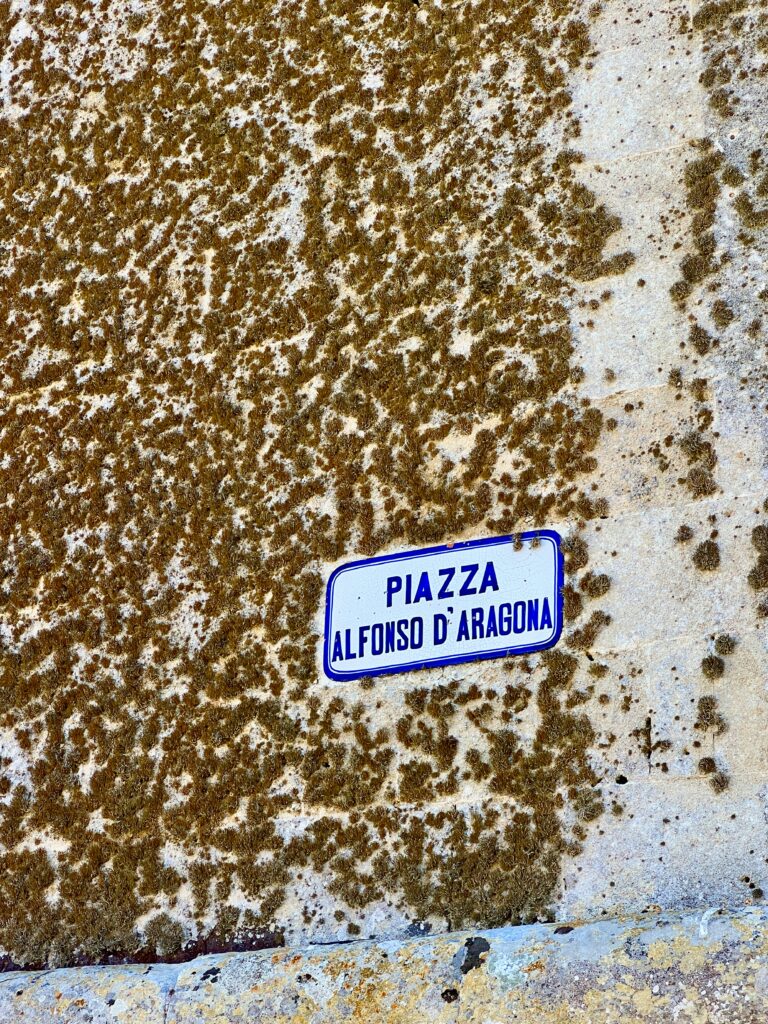
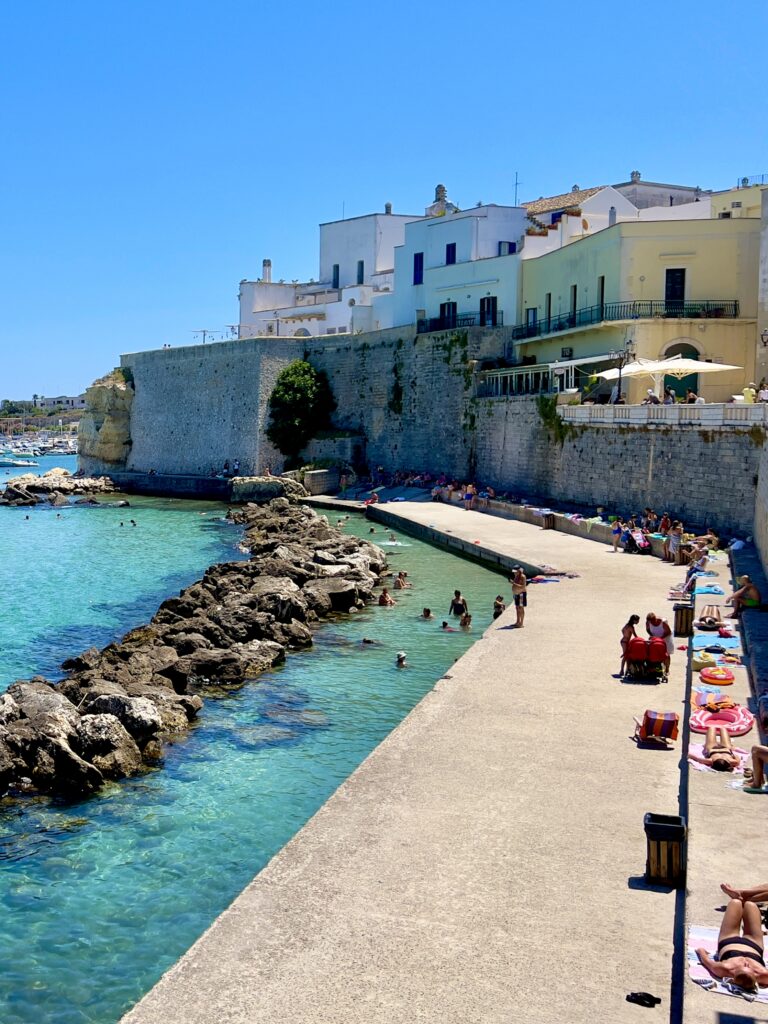
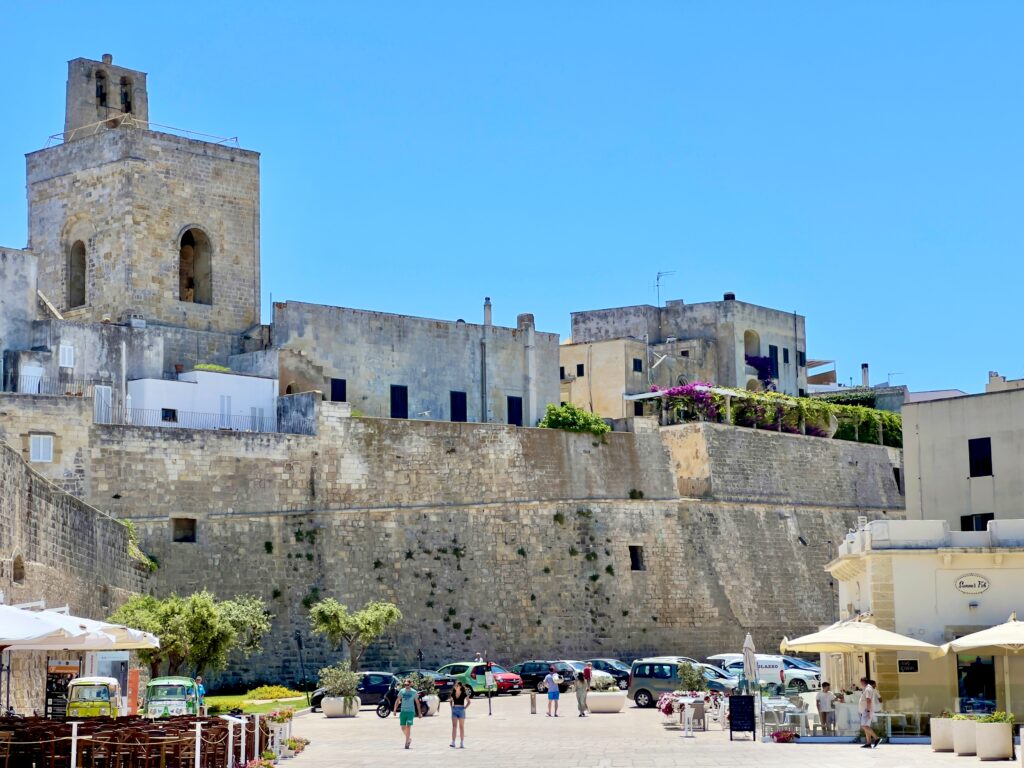
From the northern end of the bastion, the city’s most recent expansion on the left is obvious. Beyond the city is the Idro River.
Returning to the historic center head along the length of Piazzetta De Ferraris and onto Via Garibaldi, take a right onto Via Capt. Maiorano and then another onto Via Rondachi, where you’ll find yourself standing before the apse of Otranto Cathedral. Circling the church, you’ll emerge onto Piazza Basilica, where a gap in the city walls opens up to views of Otranto’s rolling countryside.
From here, follow Via del Cenobio Basiliano to one of the town’s most commanding structures—the Aragonese Castle. This fortress of mixed Byzantine, Norman, and Aragonese influences has stood for centuries, its thick walls and watchful towers a reminder of Otranto’s strategic significance. Climb to the castle’s ramparts for unparalleled views of the old town, the port, and, on clear days, even the far side of the Otranto Canal.
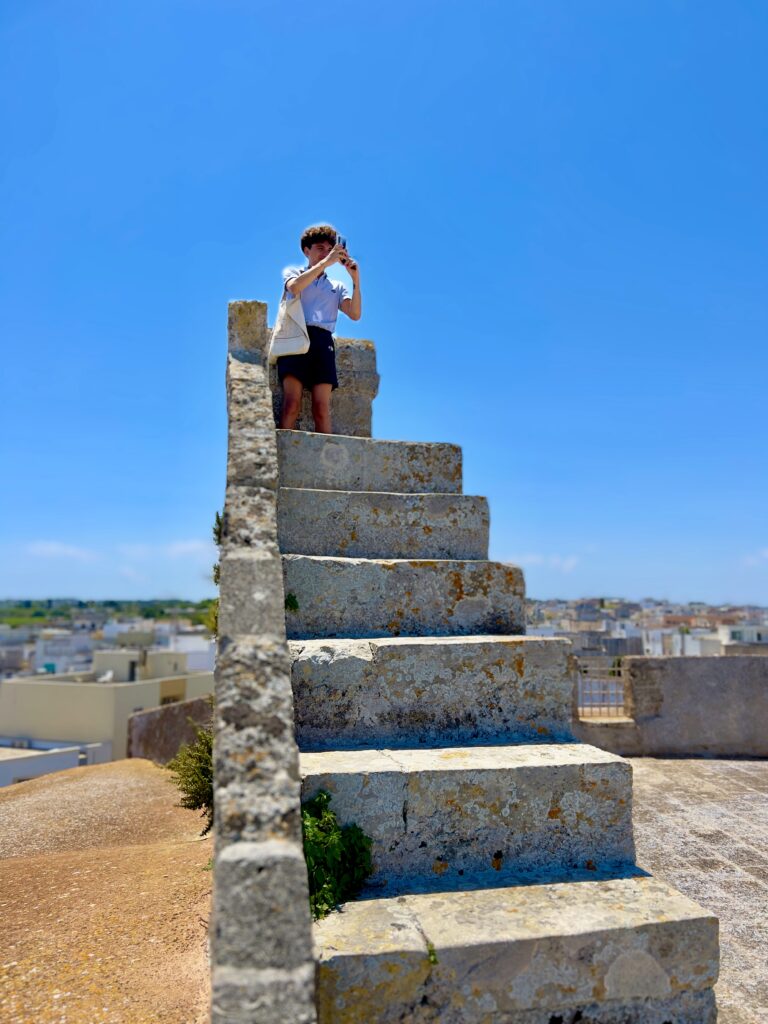
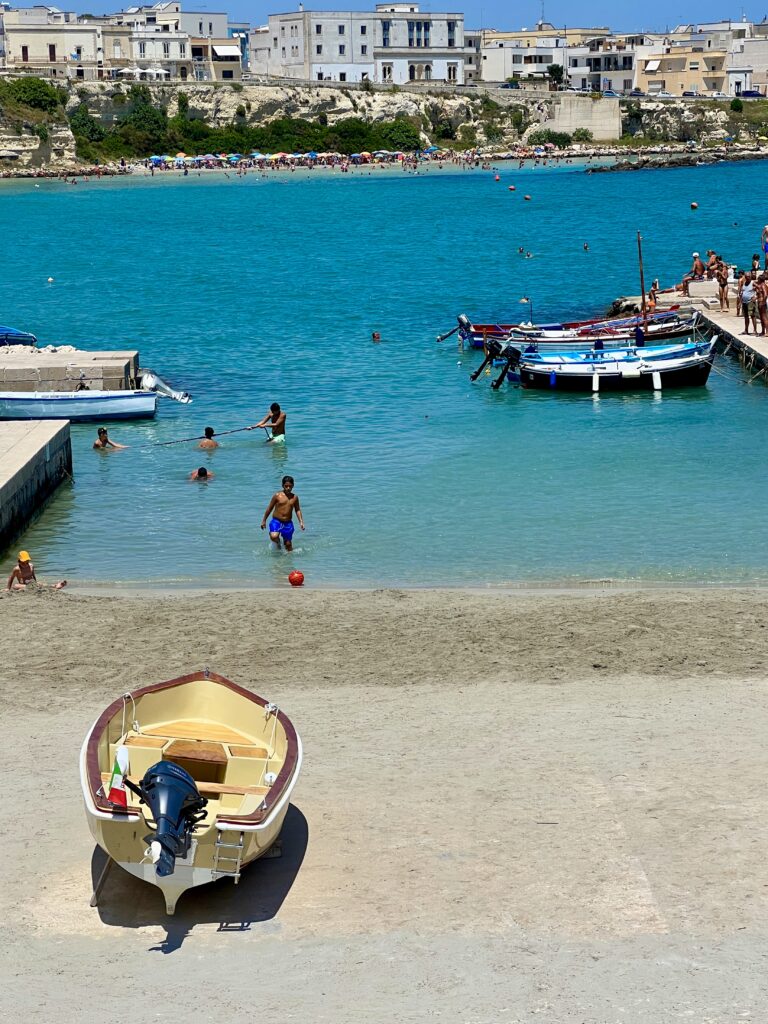
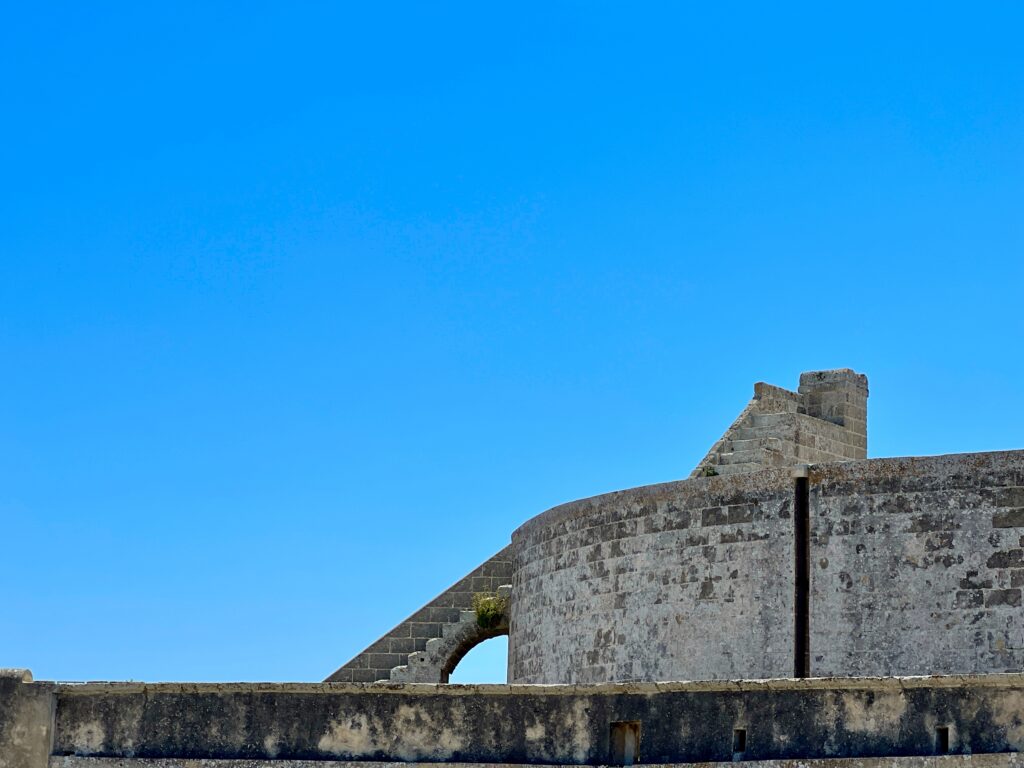
Eat Otranto | Recommended Bars and Restaurants
1. LaltroBaffo
“Dear Guest, the dishes we propose are the result of careful studies and a constant research for balance, for this reason we do not think that altering the cooking time or the ingredients will benefit the dishes”.
~ Laltro Baffo menu.
When choosing our top place to eat in Otranto we had only two criteria: seafood and somewhere away from the crowds. Actually we had a third – a cool air conditioned interior was a must. By mid-afternoon the temperatures were creeping up to 40°C | 104°F. Read about the Puglia Guys visit to LaltroBaffo.

2. Da Sergio
Enjoy a classic Italian meal at this charming restaurant, specialising in local seafood dishes. Try the fresh seafood pasta (but remember pasta dishes are primi, not main courses. We eat them before the main, so keep that in mind if you are expecting a fuller plate).
3. La Bella Idrusa
Wood fired pizza, our Otranto pizzeria of choice. Plus the usual antipasti platters and homemade pasta dishes.
Otranto City Beaches
Ortanto’s city beaches are all within walking distance from the old town. Pay on street parking is available along Via Punta, adjacent to Spiaggia Otranto. Swimming and sunbathing also takes place along the lungomare running along the front of the city walls.
1. Spiaggetta del Molo
Also known as spiaggia dei bambini (the kids’ beach), this is a small and shallow beach in the middle of Otranto. A popular place for locals to meet.
From here, you can also take a stroll along the seafront promenade (Lungomare degli Eroi) to the historic center and watch the locals fishing or sunbathing.
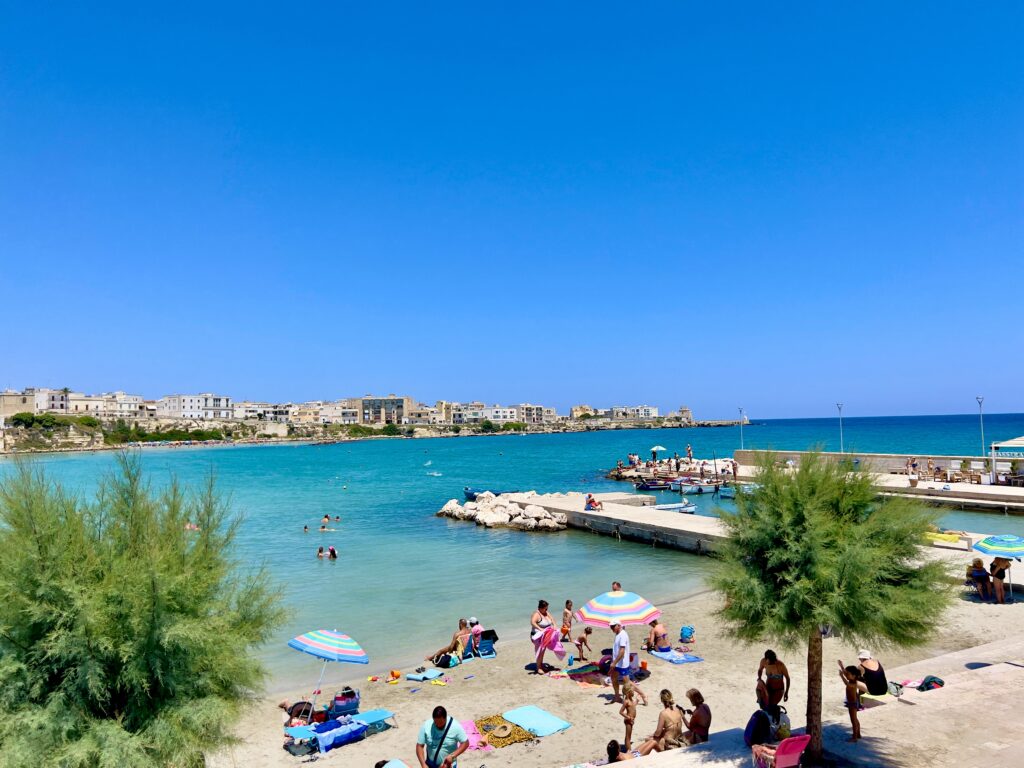
2. Abil Accessible Beach
An accessible beach where it is possible to book services to help persons with disabilities. Sandy beach and facilities.
Nearby Beaches, Day Trips and Road Trips
1. Baia dei Turchi
One of Puglia’s best known (and most beautiful) beaches. Baia dei Turchi is located approximately 6km north of Otranto. The beach has fine, white sand and a gentle sloping rake into the sea.
The nearest parking lots are between 10 – 40 minutes away on foot. Some parking lots offer transportation to the beach for an extra charge.
We recommend Baia dei Turchi Parcheggio Schito, a well organised and inexpensive car park (expect to pay around 6€ for a car, 12€ for a camper van). Only a 10 minutes walk to the beach through a defined forest path.
2. The Alimini Lakes – Laghi Alimini
Consisting of two lakes: the Alimini Grande and the Alimini Piccolo, connected by a small channel. The lakes are surrounded by pine forests and dense scrub. For canoe rentals, hiking and swimming. Pay parking available. But at the height of summer patience is required as it can take some time to get in and out (the parking spot also serves the beaches).
3. Spiaggia Alimini
Long (but narrow) sandy beach adjacent to the lakes. Highly recommended, and with lido beach clubs and bars. There are additional pay parking lots on the adjacent road.
4. Faraglioni di Sant’Andrea
Continuing north, some 15km from Otranto, this small bay with its limestone sea-stacks and arch rising out of the water is a highly recommended visit. Swimming, snorkelling and jumping off the cliffs are popular pastimes. The water is crystal clear close up and turquoise blue from a distance. Access to and out of the water is tricky for those unable to scramble up and down rocks. Many use Punta de lu Pepe. For those with accessibility difficulties further along the bay the Scala del Paradiso steps lead down to the water.
The rugged landscape makes for a popular destination for land and seascape vistas. Newly married couples often come for official wedding album photographs. Others come for the chilled out sunset vibe.
There are several nearby parking areas. The closest is Parcheggio dei Faraglioni. This has a pay and display ticket machine. Input your car registration (licence) plate and then pay (1,50€ per hour). Display the ticket on the car dashboard). Starts filling up from 10am quickly during peak season.
About a 10-minute walk away, there are three more open field car parking areas (Parcheggio di Sant’Andrea). There is a parking machine here, but it is only active in the high season. Outside of the season, you can park here for free.
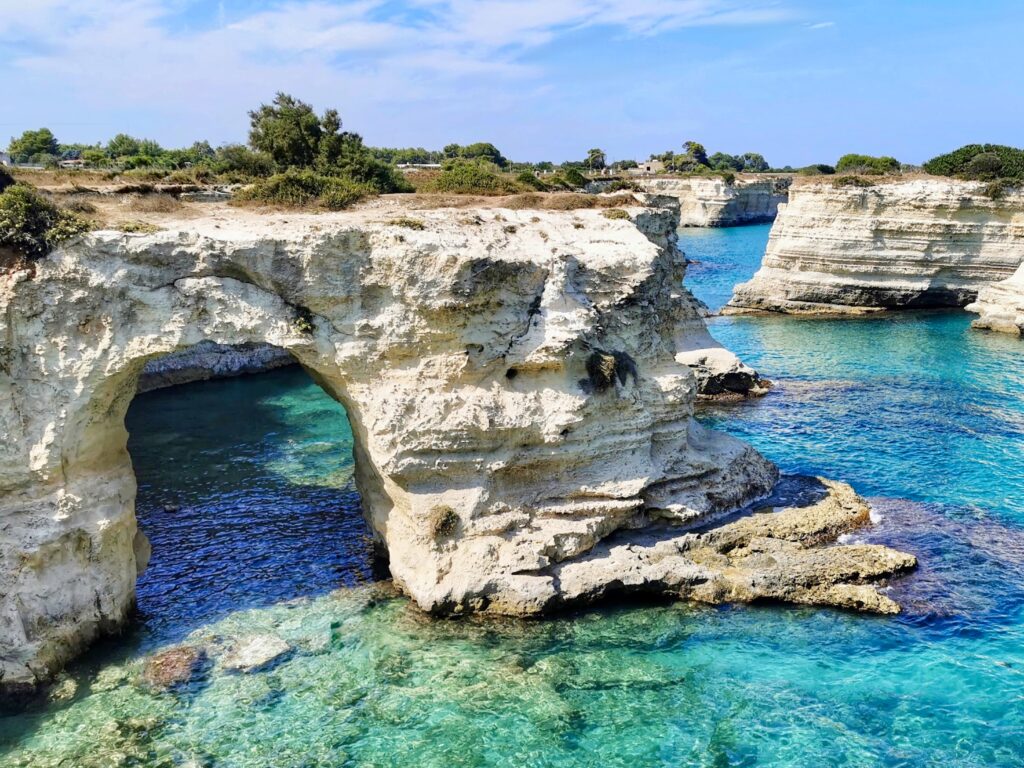
A Warning to the Curious
Anecdotally we hear and read reviews of car thefts and cars being broken into in unattended car parks, with valuables stolen in and around these destinations especially. We come into contact with hundreds of visitors to the Puglia region and not once has anyone told us that they have been a victim. Many reviewers and travel guides give this warning, but as far as we know, without any direct experience.
So, a word of caution. Never leave valuables in your car (you probably don’t at home either). Exercise common sense. We would always err on the side of caution. Which is why we would never leave luggage in our car – another of the reasons why we counsel against a frequent change of base. Choose central destinations where you can stay for 3 or 4 nights and day trip from, instead of checking out day after day and moving on just a little further.
5. Torre dell’Orso
Overlooked by the ruins of the Torre dell’Orso (the Bear Tower) it is another of Puglia’s best known (especially popular with Italian tourists) beaches in Puglia with its stunning natural rock formations.
Beach clubs and lidos run along the length of the beach, frequented by young Italians.
With soft, white sand, crystal clear sea and its gently undulating dunes dappled with maquis scrub, the Spiaggia delle Due Sorelle (Two Sisters beach) at the other end has a wonderful pine grove behind it. Walk up the trail to the top of the rocks for a great view across the beach.

6. Grotta della Poesia
Over the last decade the Grotta della Poesia (Cave of Poetry) has undergone a remarkable transformation. From a relatively unknown geological feature, of interest only to locals, to a must-visit Puglia location (it was named by National Geographic as one of the ten most beautiful natural pools in the world) and now a heavily regulated protected archaeological site.
Since 2019, swimming and sunbathing have been officially banned. Lax enforcement has meant many tourist guides haven’t yet caught up. Visitors still appear expecting to be able to swim, sunbathe and jump off into the cave. The ban on swimming and sunbathing is now strictly enforced. Jumping from the surrounding rocks is also no longer permitted. Entry to the archaeological site is permitted, but a ticket needs to be purchased. Despite this, many people still can’t resist ignoring this, especially off-season or outside hours when the area is patrolled. Please respect the integrity of this important archaeological site.
The History Behind the Grotta
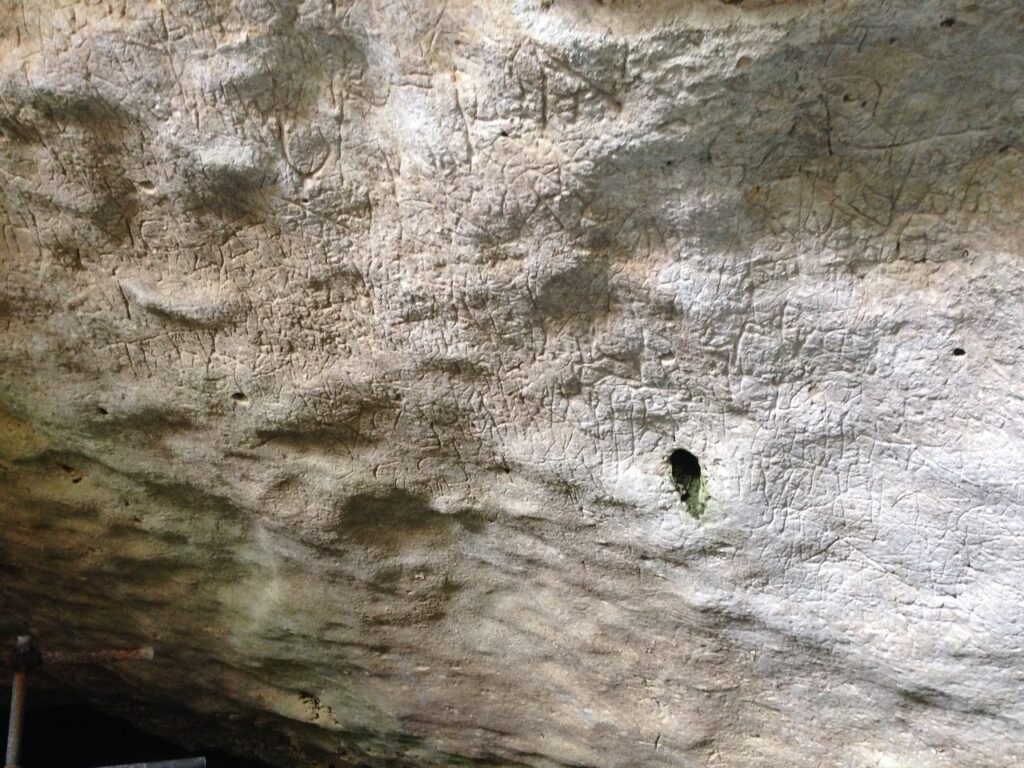
The Grotta Poesia, already known by local sailors, attracted scholars’ attention in 1983 when, following the collapse of a sea cave roof, the historian and epigraphist Cosimo Pagliara from the University of Lecce made an incredible archaeological discovery. The professor and his team uncovered walls covered with thousands of ancient inscriptions and drawings, dating from various civilizations, including Messapic, Greek and Latin writings, prompting extensive excavations. Over the next 25 years, archaeologists confirmed the status of Grotta Poesia as one of Italy’s most significant protohistoric sites.
However, increasing visitor numbers over the years led to growing concerns. The fragile limestone suffered from erosion, litter, and graffiti, and the historical significance of the site was at risk. In response, the authorities took decisive action, turning Roca Vecchia, the wider archaeological complex that includes Grotta Poesia, into a ticketed and fully protected site.
Visiting Today
Many tourists remain unaware of the restrictions, with outdated travel guides and social media posts still depicting swimming and sunbathing. However, the new rules are now strictly enforced. Swimming and sunbathing is not allowed at Grotta Poesia. But even without the social media money shot, Grotta Poesia is still worth visiting given its historic and archaeological importance. But if it’s just a swim, then there are plenty of other nearby spots with stunning vistas for that Instagram moment.
Roca Vecchia’s archaeological complex is divided into two sections. A visit should include stops at Grotta della Poesia, Grotta della Poesia Piccola, the Madonna of Roca Vecchia tower, and the fortifications built as part of Charles V’s coastal defences. A second area features the remains of Bronze Age settlements and Messapic walls. For those interested in history, a guided tour is highly recommended.
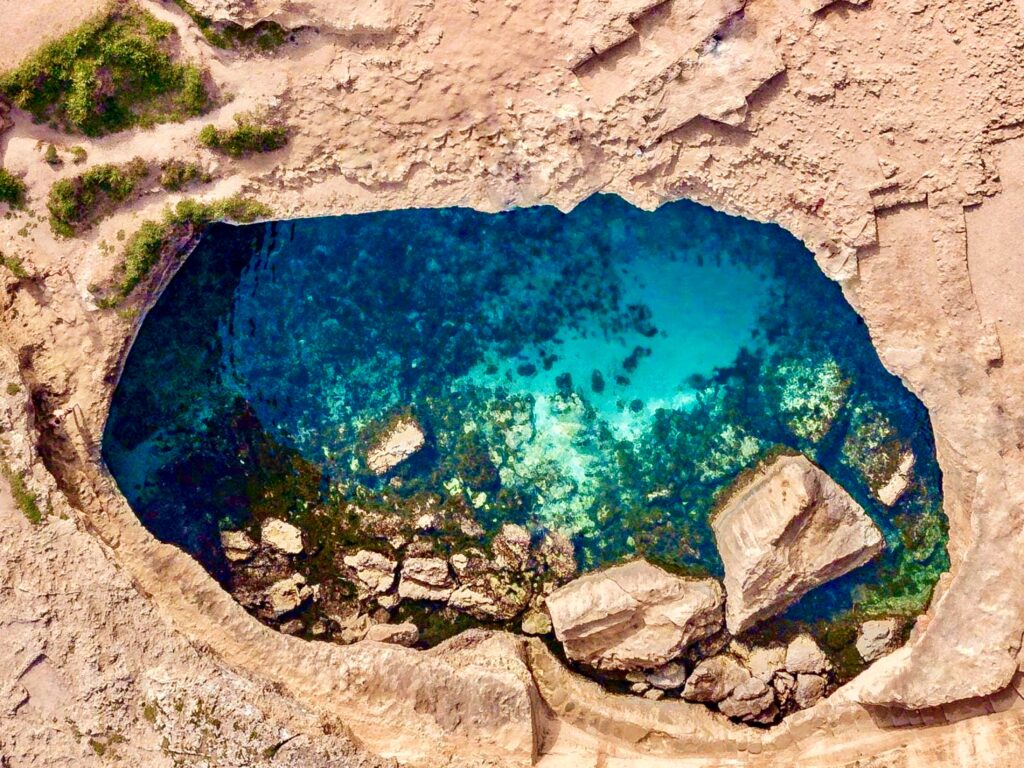
Essential Information for Visitors
- Entry Fees: €3 for adults, €2 for under-14s and over-65s, free entry for disabled visitors.
- Opening Hours: The site operates daily from 9am to 7pm in high season (May-October), but access to the full archaeological park varies. In low season (October-April), visits require pre-booking.
- Parking: A designated car park is available for €1.80 per hour. Bicycles, food, drinks, parasols, and drones are prohibited within the site.
For more information check out the Grotta della Poesia website.
7. Bauxite Mine (Grotta della Bauxite)
Heading south, take a short drive from Otranto to explore the surreal Bauxite Cave, a former bauxite mine known for its emerald-green waters and unique landscape. It’s a great spot for hiking and photography. There is a parking lot nearby (3€) and from there it’s a 10 minute walk to the lake. There is a small van selling refreshments half way along!
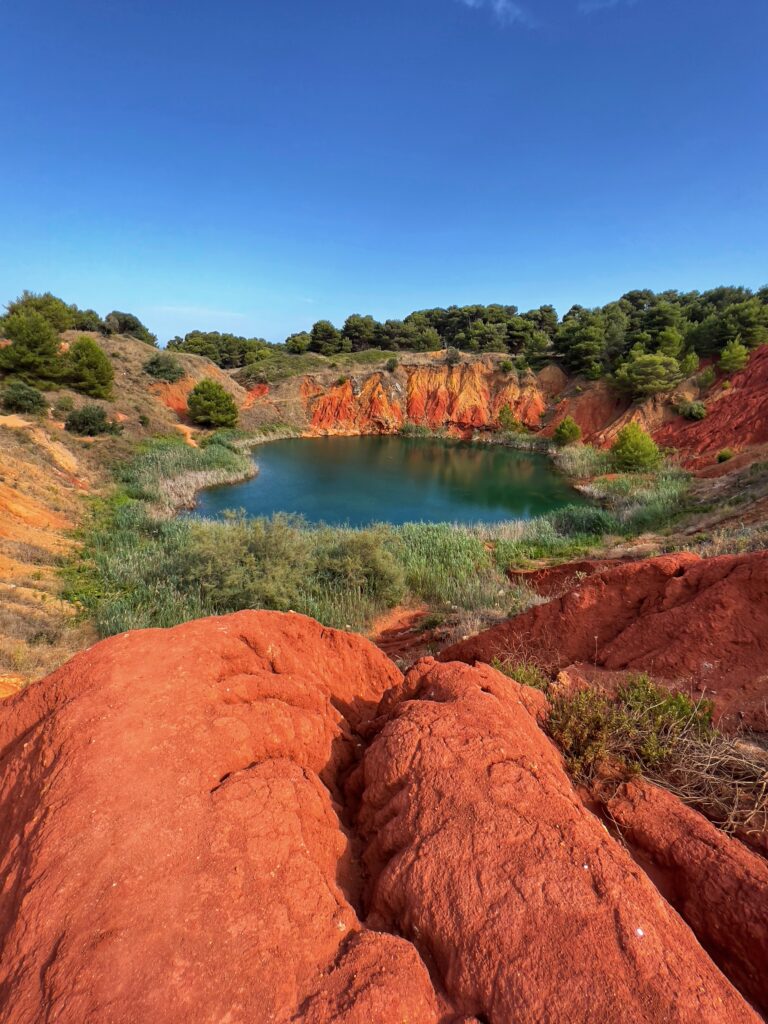

8. Punta Palascia Lighthouse
The lighthouse at Punta marks the most easterly point of Italy. According to tradition and naval charts (but not the International Hydrographic Organisation who place it 45km south at Leuca), here is the meeting point of the Ionian and Adriatic seas. The faro di Punta Palascia is still active although it is now fully automated. For enthusiasts it is identified by the code number 1983 E.F..
9. Santa Cesarea Terme
If you’re in search of thermal baths and relaxation, make a day trip to Santa Cesarea Terme, renowned for its spa waters and some interesting swimming areas.
10. Onward South to Land’s End
The Puglia Podcast
Also available on Apple Podcasts, Spotify and wherever else you get your podcasts from.
Otranto, Harbour of Love
Love comes in many forms. The Greeks identified more than five types: Eros (έρως), passionate, carnal, and irrational love; Philia (φιλία), the love of deep friendship; Agape (αγάπη), a love that transcends human limits, boundaries, and dimensions—pure and divine; Storge (στοργή), familial love; and Pragma (πράμα), an enduring love of commitment and giving without expecting to receive. Among these, there was surely also the love of discovery and knowledge—the curiosity that drove Odysseus, the yearning that only a journey can often satisfy.
The poet Meleager sang of the love of the courtesan Asclepiada in one of his epigrams:
Asclepiada, who loves love, with eyes sparkling like a tranquil sea,
persuades all to set sail into love.
The calm sea, like a woman yielding to love, tempts sailors to embark on voyages, bringing treasures and delicate kisses. Sometimes, it is love itself that inspires the act of navigation.
The legend of Hero and Leander recalls this: the two lovers lived on opposite shores of the Hellespont—he in Abydos on the Asian side, she in Sestos in Thrace, on the European side. During a festival of Aphrodite in Abydos, Hero crossed the sea to honour the goddess of love. When their eyes met, it was love at first sight. Yet Hero’s parents kept her under strict watch, and so the lovers had to meet in secret. Every night, Leander swam across the Hellespont, guided by the lamp Hero lit, shining like a beacon. But one stormy winter night, the wind extinguished the flame, leaving Leander without direction. He drowned, calling vainly on Aphrodite for help.
Hero, the maiden of Sestos, is reminiscent of Otranto, a beloved maiden sought by those who dared to reach her shores. Some succeeded, while others perished. This was the fate of the peoples drawn to the beauty and strategic location of Otranto, situated at the easternmost tip of Italy.

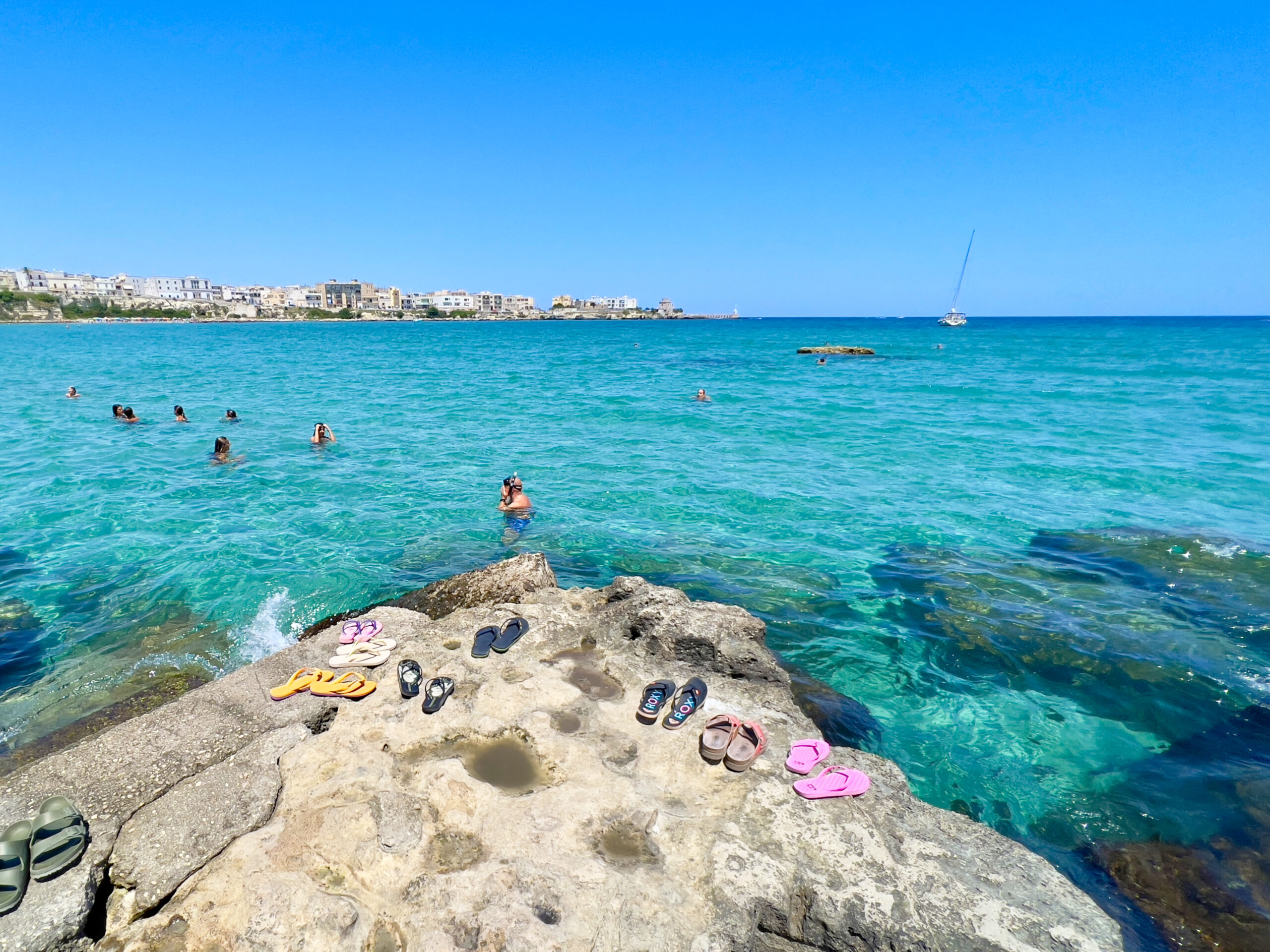

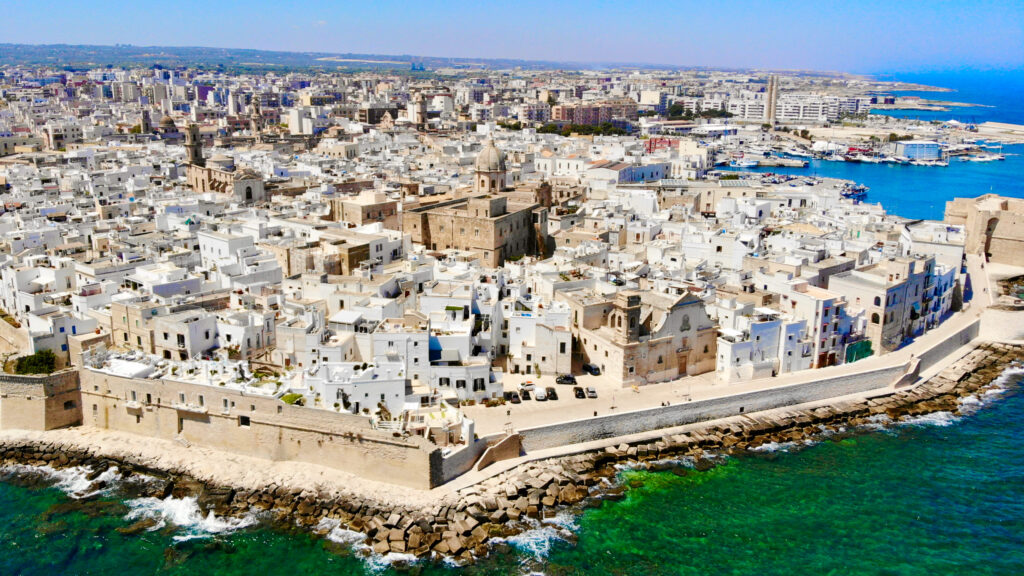

Just came back from another fantastic trip to Otranto and region. We have been there 5 times and cannot wait to go back. Other than the beaches that are absolutely amazing, we like Puglia because of its amazing food. After visiting the place 5 times, here are the most amazing places to eat (food and pastries) in the Salento area (Otranto area) in our opinion.
Matisse (Uggiano la Chiesa): https://social.quandoo.com/en/groups/matisse-lecce-105405
400 Gradi (Lecce): https://pizzeria400gradi.it
Farmacia dei Sani (Ruffano): https://www.farmaciadeisani.eu
Ristorante la Ficarigna (Specchia): https://www.laficarigna.it
Le 100 Voglie (Specchia): https://www.le1000voglie.com
Pasticceria Merola (Otranto): no website but located in the Center of Otranto
Stella (Martano): https://www.dolciumistella.it
Dentoni (Melendugno): https://pasticceriadentoni.shop
Hi! The info you provide is incredibly detailed! Thank you. We are trying to plan 13 nights in the Puglia region for our 30th wedding anniversary in September 2026. We don’t want to drive so we need private drivers to tour us. We are active and able bodied. We love unique cultural experiences, food, sandy beaches, history and views of the sea. Can you please help us map out a trip? We would be flying in and out of Rome. Staying 3-4 nights in one hotel is preferred.
Buongiorno. How exciting to be planning such a special trip, to such a special place.
Travel is so individual. When it comes to a holiday in Puglia, some like to stick to the well trodden destinations of the Valle d’Itria, still the most visited part of Puglia when it comes to foreign tourists. Some tourists like to focus on tick box holidays with a list of “must see, must do and must eat in Puglia”, whereas others prefer to holiday in the here and now, taking a much more mindful approach to holidaying in Puglia, with a flexible itinerary that suits the slow travel style of Puglia as a holiday destination.
Some are satisfied enough choosing the commercial face of tourism in Puglia, towns like Alberobello, the “easy” options of a packaged trip that plots a holiday through Monopoli, Alberobello, Ostuni, Lecce etc. The safe and “clinical” options. Monopoli, they hear, is a seaside destination with city beaches. Our guide to Monopoli highlights that while it technically is, the city beaches are small, packed during summer months, and typically rocky with very little sand, and we highlight alternative options and better beaches to visit from there.
Others focus on smaller sleepy Salento towns as a base, or prefer the gritty raw authentic edge of Taranto’s borgo vecchio, far removed from Alberobello’s tourist centric curated Trulli town. Some would rather stay in Taranto’s historic centre, than in Alberobello which people read is a “magical” experience, and because that is their expectation, it becomes so. We consider Alberobello a must-visit when in Puglia, but we find that a two hour visit on your way by to somewhere else gives you all the time you need to experience Alberobello (and we’d much rather stay overnight in Taranto’s old town than Alberobello). But knowing that Puglia is identified with trulli, tourists will plan to stay in a trullo in Alberobello for the experience and to be able to answer in the affirmative when asked The inevitable question: “Wow! You went to Puglia, did you stay in one of those hobbit homes?”
Likewise the perfect Puglia itinerary for a family of four with two young children will be quite different from the perfect itinterary of Instagram junkies, or from the perfect itinerary of foodie lovers, of the perfect itinerary of sun worshippers who come only for the beach and food (just like the northern Italians do in the month of August).
There is no one size fits all holiday or itinerary for a holiday in Puglia. Travel is individual.
Plus we are travel writers, and the Puglia Guys is a just for fun project put together by a team of people who live here and who are passionate about Puglia. We are not travel professionals, we are not travel guides or tour planners. We have no product or services to sell, or promote. We have no curated ready built holiday to sell that promises the best/most luxurious/most immersive but nevertheless one size fits all holiday package (that is ultimately driven by profit – after all, that’s the nature of business).
Also, we promote local people, local businesses and local traditions. The type of holiday we have described suits some people. We have seen American based organisations promoting authentic and immersive food travel vacations in Puglia for (typically we imagine) US visitors costing circa $4-5k with British based businesses offering almost identical holidays (for the British visitor) for the equivalent of $2.4K.
But we are not a travel agency.
That’s why our guides set out information that we think visitors need to plan their holiday in Puglia. Ostuni might make a great base in May, June and October, but we suggest its near neighbour Carovigno as an alternative in late July, August and early September. Though in October we’d suggest Ostuni over Carovigno (our guides explain why). Martina Franca is beautiful with great places to eat and amazing baroque buildings and churches. It’s a central base for exploring the Valle d’Itria. But only if you have your own transport. If you are using public transport, then it is not so well suited.
How you would might plan an itinerary for two days in Puglia would be very different from planning two weeks in Puglia.
So, while we cannot plan your holiday in Puglia for you, we try to give you the information that you need to do this yourself.
Our find the best base in Puglia Guide weighs up the pros and cons of popular destinations, based on travel style and priorities. That’s why we can’t be prescriptive. We would fail – our travel style and priorities are not aligned with yours. US visitors have different priorities and attitudes to visiting our region than Italian visitors, and theirs are different from other European visitors.
Our best beaches guide will help you locate the best beaches in Puglia near the bases you choose based on the type of beach you like. Or they can be used to guide you to suitable destinations you might want to make as a base during your holiday in Puglia.
Good food is easy to find wherever you are in Puglia. We have guides to the best typical dishes to look out for when visiting Puglia, and the best restaurants in Puglia, wherever you find yourself in Puglia. Some tourists plan their holiday in Puglia around gastronomic hubs, like Bari Vecchia, the seafood of Savelletri, Gallipoli, and Taranto, the culinary excellence of Ceglie Messapica.
Some prefer to focus on the Roman and Greek history and archaeological treasures of cities like Brindisi and Taranto. For others the geological features of the stunning Adriatic coast north and south of Otranto and that fantastic drive from Santa Cesarea Terme to Santa Maria di Leuca are a priority. Some like the trekking in the ravines around Gravina in Puglia, in the prehistoric forest of Gargano or the natural wilderness of Porto Selvaggio.
Perhaps you might want to take a cycle trip for part of your holiday in Puglia, or enjoy a cooking experience of pasta making class?
You will find all the information you need in our guides to plan for this, based on your travel aspirations and style. That’s why our guides contain so much information. But we can’t choose a vacation for you!
Our guides recommend a highly rated local travel guide who organises small group trips, and who can also help with organising drivers and transfers. But when you decide on accommodation they should also be able to help you with organising transfers and drivers.
One final thought about not driving in Puglia. In September the Italian tourists will have gone home and the roads will be much quieter. Puglia isn’t Rome, Naples or the Amalfi. We have driven from JFK to DC, from DC to around the Beltway, in and out of Baltimore on various occasions, and up the coast to Massachusetts. Driving in Puglia was an easier experience for us, especially compared with driving around DC. Renting a car here gives you the freedom to visit the exclusive out of reach beaches many tourists dream of when they think of Puglia!
Buone vacanze,
LuigiM.
Dear Puglia guys. I am organising an eight day trip to Puglia from Greece at the end of June and the beginning of July and your amazing site is my main source of information. I was really touched by your reference to all the words in Greek about love and for the knowledge you have of the story of Hero (Ηρώ) and Leandros (Λέανδρος), perhaps one of the most beautiful love stories of ancient time. Allow me to correct you about the Greek word pragma (πράγμα). In Greek Πράγμα means thing, end I’m not sure which is the word you are referring to help you correct it. Keep up the good work. Cheers.
Grazie. Hmmm. This comes from an original article that we wrote in Italian:
“Ci sono diversi tipi d’amore, i Greci ne individuavano addirittura più di cinque: Eros (έρως), l’amore passionale, carnale e irrazionale; Philia (φιλία) l’amore per un amico, la profonda amicizia; Agape (αγάπη) un amore al di là delle forze umane, dei confini, delle dimensioni, è un amore puro e religioso; Storge (στοργή) l’amore nei confronti della famiglia o dei parenti; e Pragma (πρᾶγμα) un impegno, un dare amore senza dover per forza ricevere…” by Riccardo (a classics scholar).
At first we wondered if the error came in the English translation. However, it seems the word that the error was indeeed the Greek, and possibly a formatting error: it should have been is “πράμα”, would that make better sense?
That said if instead Πράγμα Had meant “things end”, then there would have been something beautiful and poetic about that, a certain finality…
The original Italian version is here: In the meantime we will correct the word, and we really appreciate this comment, Thank you (and glad to hear that our website is helpful to your planning). Grazie mille.
LuigiM.